#i have little to no rationale for this but this is an art blog after all so here is a random little something i did on break
Text
In the SMRPG remake, Geno is still around for the postgame fights. Here's a simple and awesome way they could explain that.
(I SO hope they do something even loosely resembling this. I have so many feelings, I made gifs about it.)
Up to this point, we know that there'll be post-game content where you get to fight bosses over again. And look, our blue guy, there he still is!
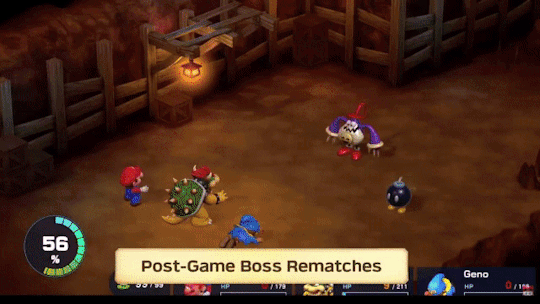
From this, it's safe to assume that in the remake, after Geno leaves to repair the Star Road, he turns right around and comes back.
Which is KIND OF A BIG DEAL. Because in the original game, it's heavily implied that for all practical purposes, he's certain this goodbye will be forever.

(😭)
For some time, I've had a little theory. I kind of desperately hope for some version of it to be part of the remake. Here it is:
Due to the events of SMRPG, ♡♪!? gets a merit promotion. Maybe, at the beginning of the story, he's not a full-blown Star Spirit (or whatever verbiage). But - as the one little star guardian valiant and capable enough to go down to the world to help save the entire Star Road - now he's become one!
And that comes with more freedom. Just imagine him crashing back down to Earth like "Yo GUESS WHAT PEOPLE, now I'm a STAR SPIRIT (or etc.) and I set my own schedule!" He can go back and see his friends! It's amazing!
And it fits exactly! With not a single caveat I can think of!
IN FACT, you might even say it's supported by a little discrepancy in some 27-year-old pixel art:

Remember the difference between Geno's first appearance and his last? He goes from this tiny lil twinkle guy... to a much bigger 5-pointed star. This is never explained....
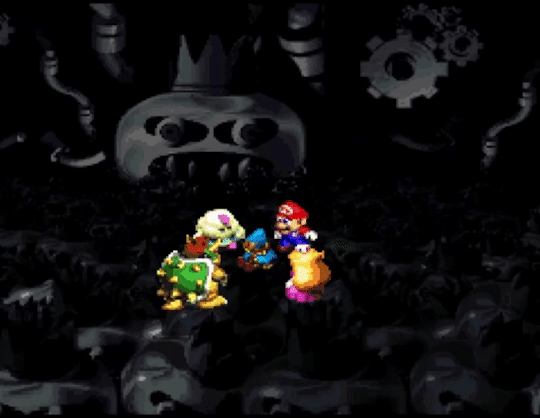
((( Read on for my rationale, more gifs, and even more feelings )))
(the doll being bigger is not explained either, but humor me)
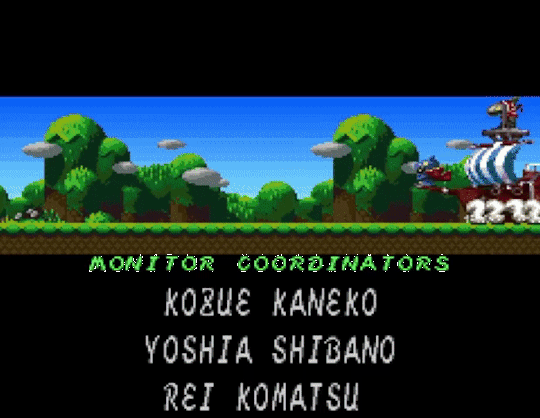
(and yes that IS him lighting things up like the Main Street Electrical Parade. I noticed that almost exactly a year ago and it rocketed this fandom back to the front of my So Cal Disney Kid brain so hard that I can't believe it took me so long to make this blog)

(only fitting that he would also usher in the remake reveal after an end like this. :'''D)
... But to me, it seems plausible that the little star's gotten stronger and grown! 💙
In the remake trailer, because I'm the kind of dweeb who does this, I went frame by frame trying to spot any telling differences -
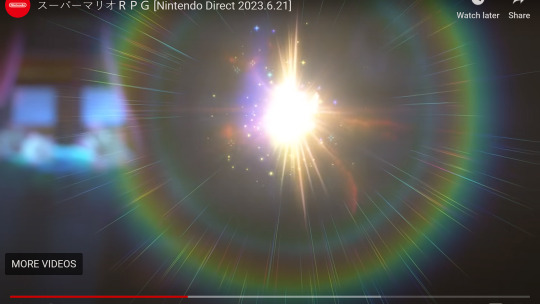
(^ the scene where he's possessing the doll - this could just be a homage to the little twinkle he looks like in the original. even if that's all, I love the devs for it)
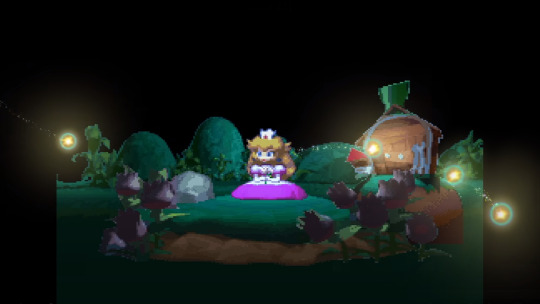
(more five-pointy? maybe? rev, did you just superimpose all the frames where Geno looks most five-pointy just so you could not quite prove anything? ABSOLUTELY)
Make of that what you will; all I can say so far is that we only see him kind of blobby. But what I'm secretly hoping is, maybe that's on purpose, so they can make it clearer in the game for the purpose of some big reveal like this. 😀
Anyway...
Wouldn't this be such a fitting and meaningful thing for Geno's character arc? I know one of the complaints among people who consider Geno overrated is that he doesn't really have an arc. Of course, his fans (myself included) either aren't bothered by that, or straight-up disagree, since he's central to the entire plot and goal of the game, and also literally the Mario universe equivalent of an angel, and maybe he was so reserved because he was trying so hard not to get attached even though we all know he totally did,
and also if he got an arc anywhere near Mallow's he'd be so compelling that he'd basically be the main character and they'd have to call it Super Geno RPG BUT ANYWAY,
I can't fully express, no matter how long I make this post, how much I hope they take a narrative route like this. It would be the actual best. My nerdy little heart would never be the same.
#in this essay i will#geno#geno smrpg#smrpg#super mario rpg#smrpg remake#my headcanons#my wishes#gif#my gifs#please nintendo please#i made so many gifs for this
74 notes
·
View notes
Text
Project Proposal
This is my project proposal
Rationale-
At first, I knew very little about coding and was really bad at art whilst my idea generation, research and writing was my strong point. For the past six months, I have learnt both technical and personal skills that have allowed me to realise what I can and can’t do. Now, I know much more about the coding in unreal 5 (nothing complex or amazing but enough to do some cool stuff) but I unfortunately still am terrible with the art (I have had to resort to tracing images as I am that bad). My writing has improved slightly as I have learnt about different ways of writing a story. I have also learnt some technical skills in how I can produce my work in creative and fun ways like character sheets that have an image of the character and information about them. I definitely can say that writing is my top aspiration whilst coding is a slight aspiration and art is not one.
Project concept-
My idea is something absolutely crazy yet unique. It will be an open world action adventure RPG with elements inspired by Elden ring, the world is largely inspired by fairy tales. You play as a character who has been reincarnated into this world after life on Earth is annihilated by aliens, you are reincarnated into a small shadow monster that has the unique ability of copying the enemy's powers. Your objective is simple: find a way back to Earth and defeat the aliens. But it will not be easy as the new world is being invaded by robots from another world. For the project, I am going to make an amazing story full of interesting characters and fun quests, a cool world inspired by fantasy and fairy tales, a small working demo and even create some locations and characters. I will be using unreal 5 to code the demo of sorts and also where I can build these locations. For designing characters and stuff, I am not good with art so I will use an AI art tool (Dall.e) to make what I want. For any human-ish characters, I will use a game’s character customization to create them as it is easy to use and very in depth. To present all this, I will have the small demo also have links to the locations I’ve built out but I am unsure how to show off the story just yet. I can incorporate a lot of time for independent study as I should have all the tools at home and want to make a really good final project.
Evaluation-
During the project, I will get some feedback from others but also reflect on it myself to see if things will work or not. I can be harsh on myself, which is good in a way, but also with the additional feedback, I can see from others if something will work out. Any changes to my project, I will note down and make sure to say in my blog along with the reason why and the feedback I received from the change. I will try to get feedback and to reflect as much as I can to ensure every step of the project is good. I will also produce an end evaluation that will assess whether or not I have done all that I have set out to do and how the develop of the project went.
1 note
·
View note
Text
1ST PROJECT
1. How are you settling in - how do you feel about being part of your tutor group?
Fine. I can just get my head down and work if I’m on a good thread and I want to and don’t feel overly distracted or frustrated with other people, but I haven’t really gotten to know any one closely yet. I enjoy being in a space where all I have to focus on is being creative and especially doing work I personally enjoy making.
2. What are your first impressions of the learning environment?
Fairly self-guided, I could ask for certain materials if needed. Getting out of it what I put in, little direct tutoring so far.
3. What are the differences to your previous learning and experience at A-Level?
I didn’t take any art classes at sixth form, so being in a space just dedicated to art is what I was looking for.
4. What if anything, do you need to find more about?
-What we actually do and don’t have access to in terms of materials, spaces, and guidance from tutors/other teachers with experience relevant to what you’re doing
-What is actually expected of you in the sketchbooks- my tutor says that it shouldn’t be a scrapbook and yet every well-graded sketchbook I’ve seen is very much a scrapbook. Do I need to write this much? Or is this too little?
-How to try different materials and get taught how to use them (ceramics, textiles, woodwork)
5. Where do you see yourself currently in terms of art/design/media?
-I have interests in working in all three areas and like the overlap between them.
6. What are your current strengths?
-Concepts, coming up with ideas out of the gate and being confident with them.
-Eye for design/what works visually and what doesn’t.
-It doesn’t take long for me to pick up what I’ve tried so far in Photoshop.
7. What are the areas you need to improve on?
-Follow-through on ideas I like but am not sure how to do
-Explaining/documenting my process- big problem at GCSE. I usually hate writing down my thought process after the fact, but I don’t mind explaining it out loud, so finding a way to bridge that gap
-Working from home
8. Record some actions that will help you achieve this.
-Document my reflections/notes/creative process in a more natural, train of thought way as I work so I don’t put it off
Week 2 09/09/18 - 13/09/19
1. How did you understand the rationale for the project?
Broadly, I understood it as making work which was true to our interests/interpretations of a particular subject, which we derived from the initial conversation and brainstorm we had in groups.
2. How have you made use of your studio time?
Sketching and writing in my sketchbook, testing materials, making pieces unsure if they were going to be a part of my final piece or not
3. What is your understanding of the “Creative Process” and how it applies to your way of
Working?
Basically creating, scrapping and elaborating on ideas as they come to you- actively making inspiration. Testing materials/ideas/recycling/borrowing concepts regardless of whether or not they will work and trusting your own intuition/taste. “Sketching and writing in my sketchbook, testing materials, making pieces unsure if they were going to be a part of my final piece or not”
4. How have the contextual references you have found helped you think about new
approaches to your work?
The book “No Sleep” by Adrian Bartos has been a huge inspiration so far- seeing how nightclub and event promoters designed flashy, attractive and personality-filled posters considering the lack of resources compared to what I’m capable of in Photoshop has made me want to take advantage of the platofrm even more, and have more fun with the design. Design elements like dithering, blocky type, collage, and repurposing sha
5. How have the practical and material elements of the work gone? (a) have you kept
Notes?
Working with ink is fun and something I’m used to, but smudging and miswriting can be frustrating considering the inital aesthetic I was going for was meant to be more clean and technical. Later, while I moved into digital collage, all of my base materials were physical, and working with plasticine meant that I was also able to experiment in how the texture of the clay turns into the black and white, dithered aesthetic of the collages that I was doing. For much of the early project, yes, I’ve kept notes, but I tend to forget to while working digitally
6. What could you do better in the future / what are your plans for next week?
Write and make notes in my sketchbook/blog while working, rather than having to go back and write them after the fact.
7. Have you started photographing your work, keeping the images in a relevant folder?
Yes.
8. You had a tutorial this week, how might you use that to reflect on your progress?
Figure out if I’m making the right kind of notes/how to make those right kinds of notes.
FURTHER NOTES:
There were certainly points during class-time where I had to find things to do and procrastinated, which has been a consistent problem for me in the past. This was especially true in documenting; while I was happy to go crazy and spend lots of time working in Photoshop on my collages, it was really mostly by chance that I came across that idea and from messing around with Adobe Capture on my phone, which is not the most sustainable model of working.
I had a blast researching posters from New York’s nightclub scene in the 70s, 80s and 90s, pretty much completely incidentally when we were asked to pick out books at the library at the beginning of this week
MEDIA - THE RIGHT KIND OF WRONG
Week 3 - Art/Media/Design Projects 16/09/19 - 20/09/19
First project, personal directions:
1. How well did you respond to the first project brief?
Considering the brief was (I believe purposefully) vague, and with my understanding the first brief was mostly about thinking in the creative process and being open to radical shifts in direction, I thought I fulfilled it well.
2. how well did you use your time this week?
I was really happy with the notes I made initially, and the idea of indiscriminately writing down every idea relevant to the project. I became kind of latched onto this idea of creating colourful, noisy gifs or short videos and I spent a lot of early class time working on the sound bytes for them, none of which I ended up using for my final pieces. A similar thing happened with experimenting with physical animation and a phenakistoscope, and it was frustrating feeling like I wasn’t really going anywhere with those ideas. However, I felt like they are getting me closer to my original idea.
Week 8 Art/Media/Design Projects 21/10/19 - 25/10/19
Third project, identifying future directions:
1. Identify overlapping themes, particularly in your personally directed work:
a. are there connections between ideas, approaches to materials or attitudes
that you have you used in all or any of these projects. If so, what are they? If
not, what are the main differences?
-Digital collage has ended up being something I used a lot more than I anticipated I would, since most of the work I’ve made independently before the Foundation year has been gouache and physical collage. I definitely follow the same process of sketching out mostly complete final piece ideas and doing extensive research, but I’ve also found that both projects have had a pretty radical change half-way through.
-I think research being a big part of my projects is a consistent theme for me, but I also consistently have a hard time documenting all the progress, since I’m not sure how to in most cases.
-In terms of consistent themes, all three were relatively different in themes; Media had to do with the supernatural, which is a theme I’m familiar with and interested in, and involved dipping my toes into animation and sound design; Art was based off of an idea I had had well before the project, and involved participatory art being being in a more curatorial role.
Compare how you have used your time between this project and the last. Consider
being open to different ideas and potential changes in direction.
exploring and evaluating different material possibilities.
creating more complex or unexpected outcomes.
developing an understanding of different artists and designers working in a
similar area.
creating a better understanding of the different approaches to practice in each
area.
presenting and/or explaining your ideas to others.
-I think organisation and note-taking has been a problem on both projects, I want to make the split between in-studio and at-home work more proportional, with time management being more of a problem with this project especially.
-I definitely haven’t been afraid to change direction, almost to a fault, since I closely documented every thought/decision that has gone through my head
Looking back over the last eight weeks are there patterns emerging in how you manage your project work?
-I definitely either latch strongly onto an initial idea, or don’t have one at all and do research, and I have a hard time working in that in-between stage when I need to develop an idea (especially if it’s one I don’t feel strongly about, such as with this current project.
Begin to outline your own particular strengths and weaknesses in relation to all of these approaches. Consider where/ how you fit into these different ways of working.
-I enjoy the research and
-Documentation in general is difficult for me, as it was at GCSE, especially since I have been tending to do all my digital work and research digitally. However, I really enjoy doing research for my work (something I have been doing for a long time, looking up references/inspiration/learning about the subject) the problem is just in getting my thought process and research down.
-I tend to treat the prompt or brief pretty flexibly, which hasn’t been such a problem on the first two projects since experimentation and being open to ideas was a major part of them. Despite the specificity of the Design project’s prompts, and my confidence in how I was going to approach my second try at that project (Switching from the Train Station to the Selfridge’s prompt)
List some of the artists, designers, photographers and filmmakers that have had the
most influence on you in the last eight weeks.
what disciplines or areas do they work in?
what subjects did they study?
-Stephen R. Johnston
-Charles Freger
-Mason Lindroth
Use this week’s reflections to identify, or confirm possible future career directions.
-This last project has gotten me thinking about Illustration as a career differently. My initial difficulty with the Design project, criticism I received from my tutor about approaching the Selfridge’s brief by design rather than brand, and the fact that I changed briefs halfway through all of this project made it more frustrating than the previous ones, which is slightly discouraging because it was apparently the most “illustration-y” of the three, and illustration was the pathway I was considering choosing.
Ensure you have your Digital Portfolio updated.
19 notes
·
View notes
Text
Discussion from an anon:
Hi Alice. Thanks for maintaining this blog. I really apreciate your posts (especially the large walls of text). After calming down a bit about the rule changes, I decided to leave my 2 cents about it in your inbox for you to discuss, comment, or simply ignore: My suggestion against national bias would be to put one more judge on the panel of international competitions and leave out the skater's "home" judge's scores completely. For other skaters without a judge on the panel, either use the full panel or cut out a random judge. This is not perfect, but it could be a start. Of course judges could still downscore "their" skaters' rivals. Or countries could pair up like "I score up your skaters, you score up mine". But it would eliminate the direct boost. My second input is totally hypothetical as I am fully aware it's never going to be implemented. But I believe with current state-of-the-art-technology it would be perfectly possible to make judging more objective. It would require a lot of work on creating algorithms to evaluate the data, but I think we could support or even fully replace most of the tech panel's work with computers. Even some GOE bullets could be evaluated - especially now that skaters are not even encouraged to match their jumps to the music anymore. We might even get statistical data on some criteria for TR and SS. Only the truly subjective components as PE, IN and CO would be solely left to the judges. In other sports where humans are not capable of fully judging fairly, we use technology to support them. But somehow I feel people would be very opposed to this idea in FS. Maybe they want FS to remain a totally subjective sport? Anyway thanks for listening/reading and have a nice day.
Hi, first up, thanks a lot for sharing your thoughts. I love reading these and I just now realized that I should’ve enabled submission on this blog a long time ago, so you guys can share these lengthier opinions without having to break it down into chunks in the ask box. In any case, better late than never, I’ve done it now (submit link) so do please feel free to use it next time :)
Now my own 2 cents, in response to your suggestions.
I’m not sure how effective the removal of the “home” judge from a skater’s score will be. Currently, the ISU is using a trimmed mean method to calculate GOE and PCS, so most of the times the high score from the home judge is already excluded from the final calculation. Of course, there are cases in which the scores are, say, 6 - 7 - 7 - 7 - 7 - 7 - 7 - 9 - 9, in which one of the two 9s came from the home judge. The home judge’s outlier score, in such cases, facilitates the inclusion of the remaining outlier, which should have been removed in normal circumstances, and as a result indirectly boosts their skater’s score. Such cases are quite extreme though, and its effect relies on either pure chance of an outlier score, or collusion between two or more judges. A much more popular form of national bias, I think, is the home judge consistently under-scoring all skaters who are not from their country, and that, as you pointed out, is an issue this removal of home judge will not be able to address.
I am an avid and ready supporter of using technology in FS judging. High-speed cameras should be able to replace, or at least enhance, most of the works currently done by the technical panels on jumps. Under-rotation, pre-rotation, takeoff edges are all objective criteria which can be verified easily and left little to no room for human errors. Technical calls on spin and step levels would require more investment in technology, but with the advent of machine learning, it is not impossible. You have no idea how refreshing it feels for me every time I switch gears from watching skating to watching tennis, a sport in which technology is fully embraced and has, for all intents and purposes, eradicated human errors from the scoreboard.
I’d say there are 2 reasons why we have not seen a lot of technological advancement in FS judging. One, the ISU is an old organization. Most of the people governing this sport are traditionalists who view technology with, at best, skepticism. There’s also the fact that, at the end of the day, skating, by its nature, will always remains a judged sport. Subjectivity and human judgment can never be completely eliminated from competition, and not a few fans of the sport actually enjoy things the way it is. I have come across countless discussion among older fans in which people lament the good old days of the 6.0 system, which, according to them, allowed skaters more room for creativity (it is not an unfair point, though it’s worth noting that such artistic liberty went hand-in-hand with an obtuse, muddled judging system which alienated any attempts by fans to understand its mechanism). Even today, there appears to exist in the ISU a mentality of “judging will never be completely objective, so what’s the point in trying”.
Two, to be completely brazen about it, skating as a sport is just not rich enough to afford cutting-edge technology. There is a reason why my other favorite game, tennis, is an industry leader in sporting technology: it’s widely popular, with hundred of millions of dollars in revenue generated every year at each Grand Slam. For the ITF and the organizers of their most important events, putting a Hawk-Eye system in every center court makes hardly a blip in their financials. Can you imagine a skating federation willing to shell out 60-70 grands to install a similar facility in their ice rink? Also keep in mind that said installation can only come after the investment in R&D has proven the effectiveness of such a system. That would also require an indeterminate upfront expense which I’m pretty sure the ISU is not eager to put up.
In the absence of technology (and financial resource), what I dearly want to see from the ISU is simple and affordable enough: an audit system. After every event, pick a judge at random, cross check their scoring patterns for bias (national or no), have them written a report explaining the rationale behind the scores they gave (which GOE bullets were ticked, which PCS criteria were satisfied). Do the same for the technical specialists: audit a random sample of their calls using video replay and slow motion (no new technology is required here). Most importantly, make the result of such audit public, and establish a system of accountability which facilitates the dismissal of judges/technical specialists who do not perform up to a reasonable standard of accuracy. The findings of such audit do not need to link to restatement of past competition results, so the skaters can always leave an event without having to worry about whether or not their placements would be overturned the next day. The purpose of the audit is only to hold judges accountable and prevent them from making mistakes in the future.
Just a simple audit, why does it seem like such a pipe dream? Oh, I guess because I just watched a sample of the ISU Congress at work.
75 notes
·
View notes
Text
Light Novel Club Kindling: Family Is Irrational

I hope that you all are reading along with us as we dive into the third selection of our light novel club, How a Realist Hero Rebuilt the Kingdom! This isekai tale of smart, rational, hard-working young man swept into a kingdom and given its reigns has been a joy to read so far. Right from its prologue, in fact, its given me food for thought as the protagonist, Souma, reflects upon wisdom once given him by his grandfather regarding family:
You always tended to think about things rationally. But, listen, you mustn’t do that when it comes to family. Once you’ve taken their hands, never let go.
The words from Souma’s grandfather are packed full of meaning: in the most important relationship unit we’ll experience in life, our family, we have to get out of our minds and thinkwith our hearts. Rationality doesn’t often work here, and in fact, can do irreparable harm (I’m reminded of a forced decision that the mother must make in the film, Sophie’s Choice). After all, family sometimes doesn’t make sense, and is comprised of people that often hurt each other deeply. Using rationale only when dealing with family might lead us to the decision to abandon them entirely, or if not, to love them only so much as it helps us.
And yet, what Souma’s grandfather is really telling us we must love our families unconditionally. “Once you’ve taken their hands, never let go.” No matter what they do to you, no matter what trouble they bring you, no matter how much they make you suffer, “Never let go.”
This task is both easy and not. It’s often easy to let the little things go, harder for the big ones. It’s easy for loving families to be gracious, harder when one’s family is abusive.

But also what I find that complicates this quote is something that I think the light novels will impress upon us, that family isn’t always blood nor something we fall into. The princess by chapter two is already considering what it means to be family and the value of it in relation to Souma, who isn’t thinking that way, who doesn’t have time to think about anything that doesn’t fit into the plans he’s created. Yet the quote given in the prologue must be meaningful to the story; it must be leading Souma somewhere as he takes on the burdens of being everybody’s “father” in a sense, and perhaps the honor, too, of starting a family.
I’m excited to see where all this goes and I hope you all will join me in seeing the same. Consider downloading this title (it goes to print in September, but that’s too late for our purposes) and joining us for our discussion here on the blog on July 5th!
featured art by 杉87 (reprinted w/permission)
#BtT Light Novel Club#Light Novels#Genjitsushugi Yuusha no Oukoku Saikenki#How a Realist Hero Rebuilt the Kingdom#Family#Articles
3 notes
·
View notes
Text
The Art of Environmental Storytelling
Environmental storytelling in games is the practice of artistically setting a scene to convey a sense of story to the player. Examples of this may include thick overgrowth and vegetation on buildings to suggest abandonment, or bullet pocketed walls and blood stained floors to imply a violent shootout happened in this location.
Whilst conducting weekly research for this blog over the past few months and indeed for this blog post in particular, it has occurred to me that environment and level design is probably my favourite thing about video games. Of course, story, characters and gameplay all play their part, but I have come to the realization that what attracts me to a game the most is the environment in which the game is set.
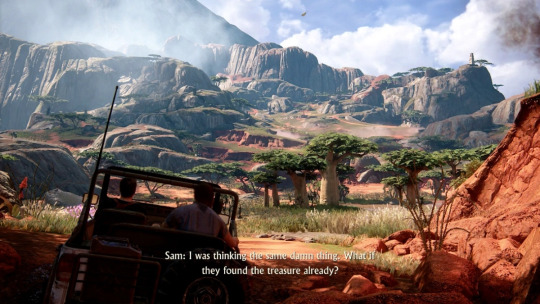
This awareness has become somewhat of an epiphany for me personally, as on top of my fondness of creating 3D environments in another unit, I have decided that when I graduate from JMC Academy, I want to be an Environment Artist.
I want to build worlds with beautiful environments like the ones I look for when playing games. The art of environmental storytelling particularly excites me, perhaps because story is probably the second most important aspect I look for in a game, followed by gameplay and characters.
So, with that said, let’s take a look at some of my favourite examples of environmental storytelling in games...
Bioshock
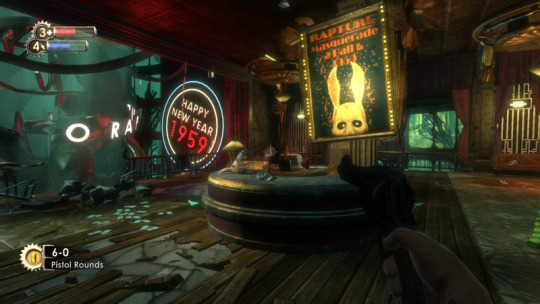
During my research, no game popped up more than 2007′s BioShock by Irrational Games. The dystopian FPS is widely regarded as one of the greatest examples of environmental storytelling in games.
The game is set in 1960′s Rapture, an underwater metropolis built by Andrew Ryan, who wanted to create a utopia for society's elite to flourish outside of government control. However, Rapture is not the glistening, underwater metropolis it once was, but a genetics-fueled nightmare straight out of hell’s darkest recesses.
At the beginning, players know very little about this world and will discover its secrets through exploration and observing their surroundings. Audio logs, bloody walls, screams from insane NPC’s and other elements are used to support the narrative without forcing the story upon the player.

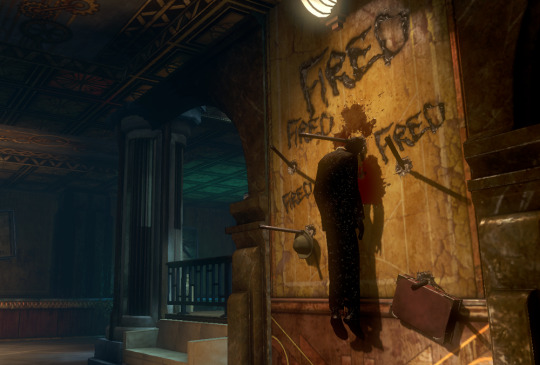
Uncharted 4: A Thief’s End
Naughty Dog’s Uncharted series has secured itself as one of my favourite game franchises and the fourth installment, released in 2016, may be the best one yet. A Thief’s End is truly a visual masterpiece and employs an epic story to match.
As protagonist Nathan Drake and brother Sam discover the ruins of legendary pirate utopia, Libertalia, founded by Henry Avery and Thomas Tew, they find themselves in a beautiful tropical environment that has been meticulously crafted with large and small details about a political pirate uprising in the past, just waiting to be investigated. This is by far my most treasured type of environment to explore.
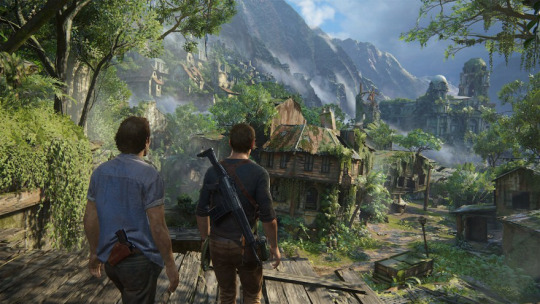
For a game that is somewhat reliant on its story, nothing is in your face with the brothers’ theorizing and discoverable documents shedding light on the possible rationale behind such a large scale battle.
Shacks, shops and grand halls brought to life with breathtaking graphics, hint at a complex social structure from a time gone we may never fully understand.


The Last of Us Part I & II
Another one by Naughty Dog, it’s starting to feel like they’re setting the bar for environmental narrative in modern consoles. The Last of Us, released in 2013 and its sequel, in 2020 hardly needs an introduction. The post-apocalyptic, action-adventure sets a far darker tone than its light hearted cousin, Uncharted.
As Joel and Ellie traverse the ruins of America’s once great cities after the world has been plunged into chaos following a ‘zombie’ epidemic, they explore a forgotten wasteland that is both terrifying and stunning. Rows of vehicles littered on crumbled roads and run-down, abandoned buildings in the process of being reclaimed by mother nature implement a beautiful contrast that makes it stand out from other games in the genre.


Exploration is rewarded with crafting materials, manuals for learning new skills and of course, extra narrative into the ‘world before’. Entering abandoned homes and taking the time to look around will provide insight into the lives of the people who once lived there. Notes left for loves ones in uncertain times, family photos, drawings on the fridge and other elements tell the story of normal people living normal lives in a time gone by.
I even came across an old PS3 and some games while exploring one house in The Last of Us Part II. I had a chuckle to myself when I noticed one of the games was, you guessed it, Uncharted!
You Naughty Dog!

References:
https://onlysp.escapistmagazine.com/environment-bioshock-design/
https://www.escapistmagazine.com/v2/the-rise-fall-and-place-of-environmental-storytelling-in-games/
https://en.wikipedia.org/wiki/BioShock
https://scalar.usc.edu/works/interactive-storytelling-narrative-techniques-and-methods-in-video-games/environmental-storytelling.plain
https://www.youtube.com/watch?v=oe6zKLae2Dk
https://watchmojo.com/video/id/18564
https://en.wikipedia.org/wiki/Uncharted_4:_A_Thief%27s_End
https://uncharted.fandom.com/wiki/Libertalia
https://nicoledegennaro.wordpress.com/2014/01/10/dont-underestimate-environmental-storytelling/
https://www.pinterest.co.uk/pin/751045675339881446/
https://plattanimation.wordpress.com/2016/05/18/uncharted-4-art-blast/
https://venturebeat.com/2016/06/01/how-uncharted-4s-artists-created-their-amazing-landscapes/
https://venturebeat.com/2016/06/01/how-uncharted-4s-artists-created-their-amazing-landscapes/
https://phys.org/news/2013-06-beautiful-wasteland.html
https://www.republicworld.com/technology-news/gaming/where-does-the-last-of-us-2-take-place.html#:~:text=The%20first%20Last%20of%20Us,published%20by%20Sony%20Interactive%20Entertainment.
https://www.eurogamer.net/articles/2019-11-25-games-of-the-decade-the-last-of-us-is-a-masterclass-in-silent-storytelling
https://financialpost.com/technology/gaming/the-last-of-us-is-a-terrifying-beautiful-emotional-tour-de-force
https://gamesandimpact.org/news/blog/the-storytelling-series-narrative-mechanics-in-the-last-of-us/
https://www.ign.com/wikis/the-last-of-us/Story
https://www.gamesradar.com/uk/last-of-us-part-2-review/
0 notes
Text
Came up with some STUPID dn ocs after talking with a friend, in that they take the role of misa but not for misogynist reasons just bc actually misa deserves better than to have to deal with any of the plot of dn in the first place.
The good timeline misa route is her never coming into contact with anything supernatural nor l*ght y*g*m* and she just gets therapy and a girlfriend and continues her successful modelling/acting/fashion/music career.
ALSO it’s to just fuck w/ dn’s plotline bc like...it’s a fun story but all of the plot choices and characterizations are very heavyhanded in terms of “this is the trajectory we’ve got plotted out and we will do everything in our power to make it happen”. so like, death of the author.
anyway I ended up writing a short fic abt them that’s mostly about Rem, and i talked at left w/ a friend abt them so i’m posting that under the cut for the sake of continuing the habit of being On My Own Bullshit thank you everyone.
Also re: misa’s only relevance in the story being A - to Be A Woman(TM), and B - progress the story by making a ~mistake~ that endangers light. also the eyes or whatever. but tbh? She could’ve done everything else the same but as long as she hadn’t just killed that one guy and tipped L off to the eyes he’d have been DEAD like i know all his little leaps of logic from the minor clues light and misa give him are to give him a fighting chance in the supernatural BS plotline. but lol. This blog is a misa amane apologist only zone.
SO the general intent behind the OC’s at large is in that what if death note had characters with u kno... Real Morals and even kind of nuanced politics, even a little. Canon death note has what? Matsuda? Please people. Also what if it was character driven instead of plot driven / But A Vehicle For Logic Puzzles™
Making this AU I am here for the two-tiered self indulgence of “what if...the shinigamis just like, hung out. just chilling” what if DN was a black comedy. or at Least a slice of life. in my dreams it is.
These ocs being the vehicle for the viewers to look at the complete trainwreck of the DN plot and go “hm! Yikes! I literally respect none of you people!”
In addition is like. a general desire to call out L on being like...genuinely kind of a bad detective hhhh im sorry i LOVE the man but. so many of his deductions were entirely based on what was conveninet to the author for him to get right. autistic KING i love you but none of your rationale would hold up in a court of law
Thursday, 22, goes to local uni and is in the last year of their degree . Has a weekend night shift part-time job.
They volunteer at the public library and recently gave away presidency of the book club them and yuzu are in (yuzu was the previous president before she entered graduate student hell).
Autistic king! Also congratulations in this plotline they have gained survivor’s guilt a la Rem telling them about how they’re literally living on borrowed time, and also their would-be murderer killing them. (*narrator voice* this will be plot relevant later)
Also the would-be murderer character is a Relevant Character that while i’m still fleshing out is integral to their character arc. We long emotional rollercoasters and non-static characters in this bitch.
Yuzu, 23, graduate biomed student, busy and stressed
Vaguely based on 2 people I know who are both bio majors so at least there’s real world knowledge backing up the understanding of this character. Not about biomed specifically tho, oh absolutely not.
Thurs & Yuzu’s dynamic is basically the opposite of near and mello, or what my understanding of near and mello, in that Thurs is small and autistic and Feeling Openly, while Yuzu’s main feeling is Being Kind Of A Bitch, but with good intent, But Still A Bitch. She has a sensitive core under 14 layers of barbed wire, and gets a bit pedantic in her logic that she ends up sort of seeing the forest without caring for the trees. Chill.
Kol, 27, works as an art teacher at the community center and has friends who work in the children’s theatre department so he volunteers there sometimes too.
Kol is like “im here i guess, but do i need to be? Be no i’ll be here I just want to put on record i am Not qualified to be an authority figure in this kind of situation and would prefer if it was anyone else”, but also secretly he’s on all levels 1 bad week away from becoming just completely unhinged, but despite this he’s also the one who’s closest to achieving self-actualization and thus the most well-adjusted out of them all. Hence, a Real Adult.
And while he hates his role as the Responsible one he’s also tbh? Kind of jamming to the concept of shinigami, not in the murder department, but in the “Rem! If you’re willing we could make some really fun homebrew ghost footage Are You In?” he is but a man who enjoys DIY art. Also he has never read a book so jot that down.
So they didn’t even have names originally i just mentally refered to them as X, Y, & Z / wrote them as such in my phone note rem POV fic, However i have the facts about them now.
Thursday’s character summed up is “i WILL cry and this IS a threat”, Yuzu’s is “what, you mean you Wouldn’t use the death note? Pussy”, and Kol is at all times resisting the urge of asking Thursday if they can borrow ownership of the DN and introduce Rem to his friends in the theatre department.The potential for shinigami special effects haunt his dreams.
Also when I did make there names there’s like....some EXTREME bullshit circular logic to them that I will not get into but I want everyone to know it exists nonetheless. Except Yuzu. Her’s is just bc it started with a Y. Yuzu stans only.
0 notes
Text
The Next Big Thing in best beginner piano
“THE more you dig into a piece of Ives, the greater pleasure you get from it,” the pianist Jeremy Denk said lately, sitting at a piano inside of a rehearsal space in the Juilliard College. “It’s like resolving a puzzle.”
Then he enthusiastically deconstructed Ives’s “Concord” Sonata, untangling and conveying the themes and motifs embedded inside the complicated textures of the interesting rating.
Mr. Denk is about to release a disc, “Jeremy Denk Performs Ives” (Think Denk Media), showcasing two piano sonatas, an esoteric decision of repertory for a debut solo album. But then, there's nothing generic about this adventurous musician. His vivacious intellect is manifest equally in his actively playing and on his blog site, Think Denk, an outlet for astute musical observations and witty musings, irrespective of whether a lament about inedible meatballs or simply a spoof interview with Sarah Palin.
Mr. Denk will demonstrate his a lot more mainstream credentials when he performs Liszt’s Piano Concerto No. one with Charles Dutoit and the Philadelphia Orchestra commencing on Thursday for the Kimmel Center in Philadelphia and on Oct. twelve at Carnegie Hall.
Mr. Denk argues that the Ives sonatas, composed early during the 20th century, are mistakenly categorized as avant-garde is effective rather than “epic Romantic sonatas with Lisztian thematic transformations.” To your informal listener, the tunes that Mr. Denk describes from the CD booklet as “excellent, inventive, tender, edgy, wild, first, witty, haunting” can certainly audio avant-garde. Ives, who produced his residing in the insurance enterprise, incorporated jazz, riffs on Beethoven and American hymns, marches and people music into his daringly experimental piano sonatas, rich in polytonality, thematic layering and rhythmic complexity.
“It’s so splendidly in-your-facial area,” Mr. Denk explained, demonstrating a very maniacal passage inside the “Concord” Sonata. “It’s also fairly surprisingly hideous. There is one thing maddening about his humorousness. Ives is continually thumbing his nose at you in a way.”
But Mr. Denk implies that Ives’s tenderness, which he illuminates wonderfully With this recording, is underappreciated. “Ives is frequently about factors recalled,” he stated, “or Recollections or visions fetched from some tricky spot.”
He played the harmonically misty passages in the next motion with the “Concord,” in which Ives directs that a piece of Wooden be pressed around the upper keys to create a cluster chord. “It doesn’t feel gimmicky in the least to me,” Mr. Denk reported. “It’s all blues in The underside. Ives understood the best way to use Individuals small clichéd bits of Americana in a method that suddenly gets your intestine. You can’t consider how touching it truly is.”
Mr. Denk, 40, has actually been keen about Ives due to the fact his undergraduate times at Oberlin in Ohio, where he carried a double key in piano functionality and chemistry. “My full double diploma experience was to some degree of the ongoing freakout of 1 form of An additional,” he explained.

youtube
He were a “really nerdy high school university student” that has a limited social lifestyle, he claimed. “Ever given that I had been a kid I wished to head to Oberlin and preferred the liberal arts. Clearly I really get intensive enjoyment from drawing connections between items and poems and literature and concepts.”
Mr. Denk described himself to be a “practice maniac,” but his horizons have prolonged much further than the follow space given that Oberlin. Though nibbling an enormous piece of chocolate product pie at an Upper West Aspect diner close to the apartment he has rented considering that around 1999, Mr. Denk referred to his blog site, calling it “an astonishingly very good outlet to release tensions of 1 form or An additional.” He claimed it had drawn new listeners to his concerts. An avid reader of liberal political weblogs, Mr. Denk desires of creating a classical audio version of Wonkette, he said, but that could be tough to do devoid of offending people today. And he attempts to avoid offending folks, he additional, although he did lately post a rant about application notes.
Mr. Denk, who phone calls himself “an actual Francophile,” is soft-spoken but powerful, his dialogue peppered with references to numerous “obsessions”: coffee, Ives, Bach, Proust, Baudelaire and Emerson.
He went off on “a Balzac mania” a couple of years in the past, he claimed.
“That was a hazardous time, and anything in everyday life seemed drawn out of a Balzac novel,” he added. “I missing about a few a long time of my lifestyle to Proust. I’m positive it modified all the things, together with my taking part in.
“Someday my supervisor was like, ‘Dude, You must focus on your career and obtaining your things with each other.’ ” At that point, Mr. Denk claimed, “I was bringing Proust to meetings.” He extra: “I’m unsure I really experienced a job route. I had been just undertaking my Strange factor, which probably gave the impression of a disastrous nonroute to many of the people that ended up observing in excess of me. I don't forget some exasperated meetings with my management, but they were being quite affected individual and devoted, which I’m insanely grateful for.”
Mr. Denk grew up in Las Cruces, N.M., considered one of two brothers, a son of music-loving nonmusician moms and dads. His father, who's got a doctorate in chemistry, has become (at distinct moments) a Roman Catholic monk plus a director of computer science at New Mexico Point out University.
youtube
Mr. Denk remains addicted to the chili peppers of Las Cruces, he explained, seemingly only 50 % joking: “The purple as well as the inexperienced and the whole spirituality of chili peppers. It’s however a huge Portion of my lifetime. Once i go dwelling I visit this true dive and obsess more than their inexperienced meat burrito.”
When not on tour, Mr. Denk spends time along with his boyfriend, Patrick Posey, a saxophonist and also the director of orchestral things to do and arranging at Juilliard, the place Mr. Denk been given his doctorate, finding out with Herbert Stessin. Mr. Stessin recalls acquiring been amazed by “the maturity and depth” of Mr. Denk’s actively playing and remembers him as “an extraordinary student who absorbed items quite rapidly.”
Mr. Denk stated he “was in school permanently” right up until “in some unspecified time in the future I decided to have faith in my own instincts.” Now he teaches double-degree undergraduates on the Bard University Conservatory of Songs. The pianist Allegra Chapman, who examined with him, mentioned he was “worried about a great deal much more than the notes on the site, always citing literary and historic references.”
“Now I try and method songs in a extra holistic perspective,” she added. “He may be very passionate. He used to leap within the place and bounce about and wave his arms. It absolutely was genuinely enjoyment. He tried to get me to look at the new music having a sense of humor.”
This blend of enthusiasm, humor and intellect, so vibrant in both of those Mr. Denk’s participating in and his creating, is what distinguishes him, according to the violinist Joshua Bell. The two are actually common duo companions because 2004, whenever they done at the Spoleto Festival United states.
“You receive the intellectual musicians or those that dress in their heart on their sleeve with no lot of musical imagined,” Mr. Bell stated, “but Jeremy manages to accomplish both of those, and that’s great. We have now a good amount of arguments in rehearsal, that's the fun part too. The very fact we don’t generally see eye to eye keeps points clean and helps make me concern every little thing I do.”
Mr. Bell, whose alternatives of repertory are usually more common than All those of his additional adventurous colleague, claimed he wasn’t normally an Ives fan: “That has a good deal of modern audio I’m a little bit cautious. Despite having Ives, right until I listened to Jeremy. He just provides it alive. He has such an incredible creativity, and very little is completed randomly.”
Ives’s piano sonatas, Mr. Denk reported, “are in a method like animals that don’t wish to be tamed.”
“Every single overall performance needs to be so distinctive,” he extra, a single rationale he was originally hesitant to record them. Like Bach, he said, Ives leaves a good deal to the performer’s imagination.
A marvelous interpretation of your “Goldberg” Versions at Symphony House in 2008 unveiled Mr. Denk’s profound affinity with Bach. Mr. Denk will perform the get the job done and Textbooks one and 2 of Ligeti’s Études at Zankel Corridor on Feb. 16.
To help keep the “Goldberg” Versions contemporary, Mr. Denk is incorporating new fingerings, he claimed, “to reactivate the link amongst my brain and my fingers After i’m participating in it.”
“I think it’s an actual magical area If you have the muscle mass memory,” he extra, “even so the brain is in advance with the fingers.”
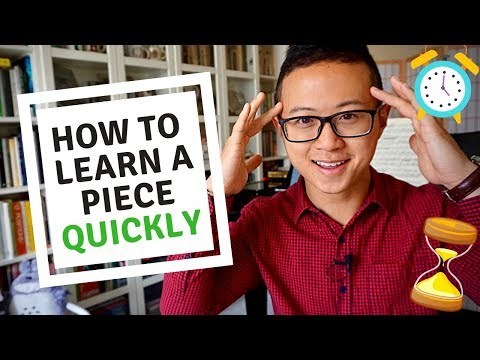
Modifying the fingerings is one way to keep away from plan, he claimed. “I get real pleasure outside of producing in a really great fingering. It can be like relearning the piece, and it makes you not just take any Observe for granted.”
The musical philosophy Mr. Denk relates to Bach, Ives as well as other repertory is maybe ideal summed up in that site put up on program notes: “I’ve in no way been a major enthusiast of the ‘Visualize how innovative this piece was when it had been created’ school of inspiration. For my money, it should be groundbreaking now. (And it is actually.) Whichever else the composer may have supposed, they didn’t want you to Assume, ‘Boy, that should are actually interesting back then.’ The most simple compositional intent, absolutely the ur-intent, is that you Engage in it now, you help it become take place now.”
youtube
0 notes
Text
FCC enables more media consolidation. The result will be less real news.
We typically blame the decline of the news media in the 21st century on one of two factors: the growth of the Internet as a 24/7 source of news and the proliferation of fake and false news.
But given much less attention is the consolidation of news media and news-gathering operations. It used to be that the federal government had strict regulations about the number of radio and television stations any company could own and forbade ownership of both newspapers and broadcast stations in the same town. Even when single newspapers came to dominate many towns, there were typically many different organizations searching for and presenting the local and national news. A series of laws and new regulations over the past 35 years—aka the Reagan Era—has consolidated media ownership.
The key law was the Telecommunications Act of 1996, which enabled companies to own more stations. Larger companies bought smaller ones and suddenly instead of hundreds of owners of TV and radio stations across the country, there were only dozens. We saw the impact on radio as Clear Channel, and recently Sinclair Broadcasting, and other companies owned by right-wingers gained control of the editorial policies of more and more stations. Pretty soon the range of opinion on radio narrowed and moved extremely right. While Rush Limbaugh began making a name for himself before 1996, it was the consolidation of media ownership that led to the domination of talk radio by Rush and his clones—Sean Hannity, Laura Ingraham, Michael Medved, ad nauseum.
Last week, the Federal Communications Commission (FCC) took a major step in making the problem worse by voting to allow a single company to own both print and broadcast media in the same town. The FCC also voted to increase the number of TV stations one company can own in any given market. It was a close vote, 3-2, on party lines. Don’t be embarrassed if OpEdge is the first you’ve heard of this awful decision. It received very little coverage; the New York Times buried the news on page two of the business section.
The Obama Administration FCC also announced its intentions to end the restriction on ownership of both print and broadcast media in 2011, but eventually backed down. This time, under its brand new Trump-blessed FCC chairman, Ajit Pai, an Obama appointee to the FCC known for his pro-broadcasting industry views, the FCC has made good on the threat.
The rationales today and in 2017 are similar: That local media needs to consolidate to be able to compete against the giants of Facebook and Google. Pai, for example, has argued that local media companies would have a better chance to compete against Internet behemoths by combining local market resources.
The argument is completely specious for two reasons. First of all, most broadcast stations and daily/weekly newspapers are already owned by large chains. It’s not the case that the various media in Cincinnati will join forces to do one great job on local news. Instead, one national giant that also controls Toledo, Ohio, Syracuse, New York and four dozen other localities will end up owning all the media in Cincinnati. The new rule will surely lead to ever greater concentration of media outlets in the hands of fewer companies.
The second problem with Pai’s argument is the confusion of news-gathering with news media. Despite the alarming decrease in the number of daily newspapers over the past few decades, the number of absolute media outlets has increased: Internet news sites, cable news and specialty weekly and monthly pubs have more than made up for the decline in newspapers.
The problem is that while media outlets have increased, news-gathering on both the local and national level has decreased, as recent studies by the Pew Foundation and the FCC . And consolidation of media outlets is a major cause. When a company buys more than one newspaper, it can use the same news-gathering staff for all the news, except for the news that pertains to each newspaper’s particular readership, something most often defined by locality. All the newspapers in the Gannet or Tribune chains get the same national and international news and columnists. But each local paper has to find its own local news, typically in competition with the three or four local TV stations, the local business paper and the local alternative weekly.
Now that a single company is allowed to own all of these local properties, the company will be stronger, but primarily because it is able to cut costs through using the same news room to cover stories. The impact on overall news production will be horrific: Instead or more editorial boards deciding what is newsworthy, one will. Instead of three or more points of view on a story, there will be only one. Instead of three or more sets of reporters trying to dig deeper, only one will—that is, on those stories that the editors and business sides decide is worthy of delving. Instead of three or more sets of opinions on local issues, only one. Finally, instead of three or more organizations with ties to differing networks of national and international news gathering, there will be but one. The result will be less reporting.
Instead of actual reporting, what we’ll see once large media companies start buying up local properties is more of the same filler that has been replacing real news for the past 15 years or so, including more opinion pieces like this blog; more coverage of celebrities and sports; more repackaged how-to’s and advice columns; more part-and-parcel use of news release, fact sheets and “articles” produced by the government, rightwing think tanks, large companies and public relations firms; and more “sponsored” news reports, which are advertisements pretending to be news.
If the FCC and the current administration really cared about freedom of the press and creating a stronger marketplace of ideas, instead of allowing companies to buy more media properties, it would implement regulations and put pressure on Congressional leaders to break up the media industry oligarchy and stop the pilfering of free content that occurs on Facebook and Google News that denies news-producing media outlets needed revenues. Unfortunately, it would take Congressional action to do most of what I’m recommending:
Limit ownership of media properties to a total of 10 properties, including television and radio stations, newspapers, news magazines, cable networks and websites, and push for expedited divestiture by the current media giants.
Prohibit companies from owning more than three cable networks, and make all cable networks provide at least two hours of news coverage a day.
Prohibit companies owning ISPs from also owning media outlets.
Reinstitute the Fairness Doctrine, which used to make every broadcast television and radio outlet to devote some airtime to discussing controversial matters of public interest and to air contrasting views regarding those matters. The Fairness Doctrine was the law of the land from 1949 until 1987, when the Reagan FCC voted to end it.
Allocate billions of dollars in aid to nonprofit or small for-profit media outlets to produce original reporting and fund it at least partially by taxing social media services and Internet service providers (ISPs) like Spectrum and FIOS for their “free use” of news.
Legalize strict principles of journalistic ethics and start to prosecute journalists and media company executives for knowingly disseminating fake and false news. I propose to walk a fine line between censorship and responsible reporting. But by focusing exclusively on the reporting of facts and not the spouting of opinions, I think we can protect true freedom of the press.
I am not very optimistic about any of my recommendations being pursued by either a Republican or Democratic administration and Congress. Politicians of both parties have cozy relationships with the mainstream news media and conservative ones seem not to mind that so much in the rightwing media is false or fake news. Thus we face an ironic future in which there are many ways to access the same limited and somewhat flawed set of facts and conjectures about current events, society and government activity.
We like to conceive of history as a steady progress of human ingenuity solving problems and bringing an ever higher standard and quality of life to more and more people. But our 10,000 years of recorded history has seen many eras in which people were far worse off economically than the decades and centuries before, for example, during the 300 year transition from medieval times to the industrial revolution during which the world experienced the “Little Ice Age.”
In the same way, we have not seen steady progress in the spread of knowledge. After the death of Charlemagne, for example, Europe entered a centuries-long epoch in which scientific knowledge and literacy declined and intellectual activity retreated into monasteries.
It seems to me that America is are entering another intellectual dark age, in which people in general will know less, be able to reason less effectively and have less access to the gamut of human knowledge, from science to the arts. It’s not just the consolidation of the media and the decline in the number of news-gathering operations that is driving the drift towards ignorance. The large number of ideologically inclined think tanks churning out false research. The gradual starving of public schools. The increased involvement of for-profit corporations both in operating schools and in supplying material such as learning guides to public and private schools. The blurring of the distinction between the entertainment and news divisions of media companies and between advertising and news. The politicization of text books. The denial of basic scientific facts by one of our two major parties. The continued glorification of celebrity and mocking of intellectual achievement in the mass media. Virtually every trend in the marketplace of ideas is making Americans less educated, less informed and less capable of sifting through assertions and understanding which are reliably factual information and which are sheer nonsense.
2 notes
·
View notes
Note
Hey Sass, I just found your blog and I've been enjoying it immensely. I'm wondering what you mean when you say you came from a non-science background. I'm pursuing a master's degree in library science with a concentration on medical science libraries, and I'm eventually hoping to apply to med school after a couple of years working as a librarian. What advice do you have for applicants with somewhat atypical backgrounds looking to go to med school?
Hey anon,
I’m so glad you’re enjoying my blog! I have more I need to post but…life you know?
Anyways, when I say I’m of non-science background that really means two things in my case. The first is that up until college my entire life was heavily focused on art. I went to an arts high school, I worked in just about every medium you could think of. I took some science classes in high school but honestly couldn’t have cared less about them. It all kind of fell apart though when I did a summer program between my junior and senior year of high school. I think I’ve written about that somewhere else so I won’t bore you with those details. But that sort of ended my art as a career situation.
Technically the second reason falls within science because I was a psych major and heavily involved in medical based research but I did a lot of data collection, article writing and statistical analysis so none of it was actual medical science. So besides my prereqs, volunteering where I basically took vitals and discharged people and some shadowing I really walked into medical school blind but enthusiastic.
So for one with an atypical, non-traditional person wanting to go to med school, here are some tips from someone who already made those mistakes;
This first stuff is a little more general but easy to forget once you’re no longer immersed in an academic setting
Make sure you have all your basic prereqs done to get into medical school, and if you don’t and you’ve already graduated look into post-bac programs. Because in the absolute short all that’s absolutely required are certain classes and an MCAT. Oh and don’t be a convicted felon I guess.
Continue to do some volunteering and shadowing in the medical field if you can just so you’re not totally removed
Map out a time line whenever you’re ready to start applying because late is BAD and that way you don’t get overwhelmed with process and the cost
Use the AAMC and AOA websites to find exactly what schools you’re interested in want; know average scores, if they like research, want specific letters of rec, or like a butt load of volunteer hours for example
This stuff if more for the non-trad
Reach out to a medical professional and learn more about what medical school consists of to know if making a full switch makes sense to you since this is HUGE commitment in all facets of your life
Don’t be super focused on saving as much money as you can because unless you’re in a situation that makes bank your loans will far exceed what you can save up in a few of years. I’m not saying be dumb but don’t think you need to live off rice and ramen for the next few years. Be smart, save some but live a life. Especially because you’ll be much more restricted later
Know your demographic, especial as a non-trad with a non-trad major. While they’e way more open to people are not 22 or a bio major it’s still a minority group. So check out school stats as well and major disbursement
Have a solid rationale for why you wanted to do something else first and what drew you to medicine despite having another career first and why you picked something not in the medical field if you planned your final destination to be medical school; it’s not that doing something else is bad, but they want to know that you’re dedicated to sticking it out and that you really want this
Relate what you’ve learned in your current field to medicine and how your experience can make you a great physician
Don’t try to cover it up! Be proud of what you did and accomplished because you have a another view on life that really can give you a unique and interesting perspective
There’s probably some other tidbits I might be missing but I think I got the gist. I hope I was able to help and good luck!
8 notes
·
View notes
Text
Do People Actually Judge A Book By Its Cover? Why Your Book’s Cheap Exterior Might Be Hiding A Literary Gem

Photo by rawpixel.com from Pexel
“You can’t judge a book by its binding.”
Passage from the African journal American Speech, 1944.
Just two years after this phrase was coined, it would go on to be adapted into mainstream idiom and pop culture, first and most notably in the book Murder In the Glass Room, by Edwin Rolfe and Lester Fuller, which featured the phrase “You can never tell a book by its cover.” On the surface, of course, this is a self-explanatory term, and even as a metaphor for any large number of scenarios and character assessments, its meaning is clear. However, metaphors and analogies aside, perhaps ironically, a field in which it is quite difficult to simply nod agreement with this is when actually judging a book by its cover.
WHY JUDGING A BOOK BY ITS COVER SAYS MORE ABOUT YOU THAN IT DOES ABOUT THE BOOK
To many, the answer may be straightforward: yes, we do judge books by their covers and no, perhaps we shouldn’t, but that doesn’t stop us. Absolutely, this is true on both counts for many people. However, there are many reasons why the answer to this question is actually more profound than it may first appear, and why its answer – individual to each of us - actually reveals far more about our own personality traits than it does about the writer, the book, the designer who created it, the publisher who chose it, or even the decision to print it. What it raises in us - those actually making the judgement - is questions of how much importance we place on perceptive visual importance, stereotypical presumptions, patience, openness to and tolerance of new talent, respect for opportunity, assumptions of financially social inferiority and perhaps more than anything else, loyalty.
IS READER LOYALTY EXCLUSIVE TO THE RICH AND FAMOUS?
To add a measure of context to that list, let’s first consider the last of them: loyalty. If I explain that in this case I mean loyalty to authors with which we have already established our position in their fandom – most likely famous – then perhaps the list might start to make more immediate sense. Consider the newest novel you bought by your favourite best-selling author – you may remember the title (you actually might not), but can you recall, without checking, the cover? Try to, right now. One thing which will almost certainly have been true of it, assuming your best-selling author is a famous one, is that his or her name was in much larger font than the actual title of the book, itself. Check your latest Stephen King or Michelle Obama book – it is a safe bet that the author’s name is at least 30-40% larger than the title. What kind of a message does this send, then? That if you are a famous, established author the cover doesn’t matter – even the title of your book doesn’t matter? If it’s a horror, it used Chiller font and a dark theme��� probably; perhaps there were pictures of balloons or a pram, but who can remember? All that matters is the author who wrote it, and that it is the one you don’t own yet. The book might be bad – the cover might be terrible - but you’ll still probably buy his or her next one.
Compare this, now, to a new, unknown author. Those of us fortunate enough to work in the literary industry with up-and-coming authors should see things – including shabby book covers - very differently, and should pride ourselves on an inclination to appreciate the less superficial qualities mentioned in that list: openness, opportunity and new creative talent; this is, of course, a vital element of our profession. As a book reviewer, beta-reader and copy-editor, I myself am acutely aware that amongst every dozen or so rough stones there is a diamond (to shamelessly use yet another clichéd metaphor). That diamond may be hidden within a low-resolution crust of an exterior, which is offensive to the eye and needs not just polishing, but entirely discarding – of course, I won’t know this unless I dig. Many new authors may be unpublished; they may also be broke financially, unable to commission anything more expensive than some free or cheap Photoshop-alternative. So, rubbing their hands in excitement and anticipation of their new graphic design hobby, they become hands-on and expand their skillset to include book covers. With glee and relish, the author then prides himself that he is able to make a cover and can now do Photoshop-ish. But, is it right? Quite simply, is it good enough?
WHY BOOKS BY UNKNOWN AUTHORS HAVE TO LOOK TWICE AS GOOD – AND BE INSTANTLY RECOGNIZABLE!
By this rationale, is it therefore fair to say that if you are a famous author - probably wealthy with a loyal fan base - we have a right to judge your cover critically and view it cynically, whereas if you are an up-and-coming new face, we should afford you leniency for your budget and withhold judgement until we have read it? After all, for all we know behind that cover may be one of those hidden gems – and, behind some there absolutely, undoubtedly will be. Well, no actually; this is the very reason why you should not expect leniency! You don’t have the luxury of a half-page author name self-selling your new book – you have yet to achieve that status. Besides, the better your book is, the more enticing your cover should be! I designed all of my own book covers, and whilst deeply proud of every single one of them, they have been upgraded and reissued over the years. Why? Because they weren’t good enough to reflect what was inside them. Whilst you should always strive to create the best art you can – both inside and outside of the cover – your book’s cover is invariably little more than a shop window, with one primary objective: to get people inside it. And, even whilst those in the business are less likely to judge a book so harshly by its cover, they are still going to have an inevitable, innate aversion to really bad covers; avoiding creating a terrible cover is a good place for you to start selling your book. In fact, I’ll admit that there is undoubtedly still some degree to which a cover might help me select my next review read. In spite of this, take a look at the BOOK REVIEW BLOG – seek out the books which have been awarded 5-star reviews and take a look at the poor quality of some of their covers; they gave no indication of the immense quality of what I was about to read.

Image property of MJV Literary Author Services
Whilst you are there, by the same inverted principle, look for the lower scoring reviews; those with a professionally created and undoubtedly more expensive high-res cover – it would perhaps be a safe bet to assume that these would have more sales on Amazon than the rough gems do. This is a tragic waste, and all the more reason why a good cover is so important. By earlier asking “is it good enough”, of course the question refers to its defining measure: good enough to sell. As far as the paying readership goes, sadly, and often inaccurately, they undoubtedly judge a book by its cover, if not totally, then to enough of an extent that this factor cannot be simply ignored when conducting your analytics – the number of Amazon sales will probably speak for themselves, as far as professional covers goes. Whilst I am certain there is a huge number of people with the sense to acknowledge that an extremely good quality book may be hindered by its unknown author’s lack of budget, there are also most definitely particular universal expectations of the cover, which are consistent with genre – if you can’t tell your reader how good the book is, at least tell them what it is about, by its cover; at the very, very least, your cover must ascertain genre, even to be visible to your market audience. Too many books hide their action-thriller credential behind a stock cover of a mountain – this means very little to a browsing reader. I earlier mentioned the horror theme, briefly; sci-fi fans will probably expect high-resolution, technologically stunning imagery and artwork; period or romantic readers may be looking for beautiful scenery or lavish, costume-wearing characters; action readers will prefer a gripping, rousing cover, maybe featuring weapons or cash; family drama may invoke expectations of emotional people in melancholy and poignant poses; take a look at the colour themes of other books in yours’ genre, because they all have them… The point is, if there is only one piece of advice to be taken from this article, it is that your cover, at the very least, must be recognizable to your target reader at first glance – or at least enticing - otherwise your marketing work is going to be a whole lot more difficult! When you are rich and famous, your cover might not need to be memorable or even good, but at first glance it will still meet the genre theme, and that will be enough.
A GOOD BOOK COVER IS AN INVESTMENT
As far as goes any degree of importance readers place on the character traits mentioned - perceptive visual importance, stereotypical presumptions, patience, openness to and tolerance of new talent, respect for opportunity, assumptions of financially social inferiority and loyalty – all people are different, and each respects some of these qualities more than others; this is a calculation you must make for yourself, as the author or indie publisher paying to produce your book, and adapt to your buyers’ persona. One thing is clear, though, and probably made more so by looking at the not-so-good books which are selling well, rather than by the good ones which aren’t: a professional book cover may not be a creative necessity, but it is a business one - a relatively cheap investment, too, considering it is your book’s shop window. Take a look at some AFFILIATED COVER DESIGNERS and their rates – you might be surprised.
Posted by Matt McAvoy: 31st July 2019
#book cover#cover designer#author#writer#publishing#books#book creation#judge a book by its cover#ReturnToRealBooks
0 notes
Note
hi~ i read your about page where you said you might write up your reasons for not liking some ft ships like the whole debate with fraxus/miraxus & chendy/rowen but i couldn't find anything on it on your blog so i wondered what were your thoughts on that? i know there's fandom arguments about homophobia and crackshipping there too. i’m a multishipper but i really like your anti posts for naruto so i thought if you had any ft ones then they might be as good! �
Thank you! I’m really glad youthat like my Naruto posts. They’re pretty controversial, so nice commentsare always appreciated! 😅 Dude, I haven’t updatedby ‘about’ page in months, so doing that write-up completely passedmy mind… Thanks for being interested though! I guess I’ll spill:
Right, this might be quitecontroversial, so remember that any opinions expressed are just personalpreferences/reasons, okay? ⚠️
Like I said on my page, “Ihave a ‘manga > anime’ complex thanks to Studio Pierrot, so I only readFT. I wanted to avoid filler brainwashing, bias and only know of canon withthis series, after the mess with Naruto…” Therefore, I only really ship thatwhich I believe is substantially depicted/suggested in canon, and kind of havea bit of a pet peeve for anything outside of that.[ #1 justificationdisclaimer! ]
( 1 ) Mir/axus [ &Fraxus ]
So I was genuinelysurprised that Mir/axus was even a thing when I started searching the fandom’s tag, onceI’d caught up. I don’t know if they’ve been implied in filler, but theywere non-existent as a romantic pair in the manga. Honestly, theyhardly had any on-panel interaction… Like, the only evidence that came tomind for “logical” reasoning behind them was chapter 380’s cover art.(Maybe 329’s, at a push.) I even tried to find somesupposed “moments” under their Wikia page, but that listed was merelyscarce interaction with no romantic subtext; each synopsis was pretty muchgrasping for straws.
Here’s the thing –you mentioned the fandom discourse of “homophobic” accusations,right? Now, I too hate when shippers (in any fandom) cry that simplybecause others don’t ship a queer pairing. Like, c’mon. But, inthis case (and Wendy’s), I must admit that I do find it somewhatrelevant… Idk if this ship’s popularity (and, more so, acceptance alongsidethe actual semi-canon pairs) is because most have been influenced byexternal material or if it’s just because there’s no other member of the opposite sex that they’re paired with, but Fraxus was actually suggested in canon; emphaticallyfrom Freed’s point of view! Even on Laxus’ side, numerous chapters have moments that – here’s the thing – anyone would undeniablyaccept if either Freed or Laxus were female*.
[ My earlier volumes are enclosed in my bookcase, but I have 49 – 57 (Avatar – Alvarez) on-hand beside my bed, so I skimmed through to find (max.) five pages to evidence Laxus’ P.O.V. ‘cause this post will already be long enough. ]

Chapter 416: “At this rate, I won’t be able to protect what’s important to me.”
It’s also worth noting that the official tankōbon/volume translation of this reads: “I’m not strong enough to protect the people I love yet.”

Chapter 460.

Chapter 462: “But that ain’t important now. All I’ve got on my mind… Is bringing the pain to the bastard who took out Freed and the others.”

Chapter 472: “So you’re the one who did a number on Freed and the others?”

Chapter 473: “Thanks a lot, Freed… There’s no wizard that could break your spells…”
*That’s the key consideration – that if you were to replace either’s gender for that of the opposite sex, it changes how these scenes are perceived. These panels, for example, are dismissed by those who oppose Fraxus, but they would be regarded as “ship moments” and a validation of Laxus’ affection if you were to replace Freed’s name in the dialogue and/or presence in the panels with a female (Mira)!
That’s why I can kind ofunderstand these claims, ’cause the existence and general fandomacceptance of these ships is very heteronormative in that respect (i.e.ignoring present queer pairings for heterosexual ‘crack-ships’) which makes it kind of discriminatory; reminiscent of homophobia perhaps. Although, I agree that term is a little extreme, as it doesn’t seem intentionally prejudiced. And whilst Freed is emphatically portrayed as queer, Laxus’ sexualityis a little more implicit, yet he is assumed straight by default… It’sironic/hypocritical because the majority of ships across all fandoms are typically founded upon onecharacter’s feelings, whilst neither Mira nor Laxus have shown said romanticinterest in each-other.
( 2 ) Ro/Wen [ &Chendy ]
Again, I hate Ro/Wen dueto a similar reasoning. Finding out that they even existed as a ship wasbaffling, tbh! I mean, at least Mir/axus had the cover as some rationale,but Ro/Wen is based solely on them being the same age… Talk aboutheteronormative? Also, technically, that’s an incorrect claim, due to the sevenyear time-skip in which she remained frozen. Like, she’s actually thesame age as Sting & Rogue. But you don’t find her forced with them. Why,because they’re older and that’s frowned upon? You know, despite the samepremise applying to Ro/Wen; since Romeo was half Wendy’s age when she wasintroduced (6 & 12).
The ship can’t even besupported with evidence, since they had no significant canoninteraction until the Alvarez Arc. Their only other contact was in an omake.Yet their age difference is evident in both; dismissing any reach atromantic subtext. In the omake, Romeo refers to Wendy as “nee[-chan]”.Similarly, she is presented comforting him like a child in their limited Alvarez panels, with him lookingup to her as that same sister figure. I have seen some of these shippers disregard Chendy asbeing “platonic”, when Romeo and Wendy’s dynamic isactually – canonically and strictly – such.
Chendy, however, do have asubstantial, visibly and literally present, mutual bond. They have extensive,plentiful interaction, as well as actually present romanticsubtext… I know that it may be difficult for (I guess) anyone outside of theLGBT+ community or a truly ‘open’ one to understand, due to ourheteronormative society – as Chendy are often disregarded as “justfriends” (🙄) – but many of theirmoments transcend platonic affection and bear intense likeness to theother romantic pairs’ depictions. For example, they are also featuredalongside the semi-canon couples in art-work, like Mashima’s couple sketches onTwitter.
Not to mention thatfriendship is the foundation of any healthy, romantic relationship! Of coursethey’re going to be best friends before engaging in such, particularly in thecase of same-sex pairs. Yet no-one uses this dialogue (of labellingeach-other as “friends”) against NaLu, despite them stating the otheras that same description on numerous occasions. But despite the justification mentioned above,Chendy are still dismissed. Again, if either were the male, it would be a completely different situation… I mean, since people shipcharacters based solely on covers and all – chapter 421’s cover (amongothers)?
Summary:
Obviously there’s nothingwrong with crack-shipping! And, no, not liking a queer pair [more than astraight one] doesn’t make you “homophobic”. But – in the case ofFraxus 🆚 Mir/axus& Chendy 🆚 Ro/Wen –I think that there is something kind of messed up with arrogantly defying acharacter’s canon depicted/suggested sexuality and/or romantic interest(s).There is something somewhat discriminatory about disregarding theirother prevalent, significant and actually developed bonds, to the extent that someone’sheteronormativity is so severe that they substitute a same-sex character foran irrelevant one of the opposite sex, who does not even have decentinteraction with the character in question; fabricated entirely from theridiculous, inaccurate [R/W] rationale of them being “the same age” or merelysharing a chapter cover.
That sounds much harsherthan I intended, I’m so sorry! Btw, I don’t blame shippers –everyone is (obviously) allowed to ship what they want! What’s stated above issimply why I’m against Mir/axus and Ro/Wen, especially as an avidsupporter of the LGBTQ+ community, a bisexual myself and a university scholar who has studied/written about this field.
[ I’ve updated by ‘about’ page now too, btw! ]
114 notes
·
View notes
Text
tfp, the ring, and the art of the false climax
(ETA: This post is causing trouble on mobile...sorry!? Many of the images are cut from mobile for some reason, and apparently it’s crashing the app. I’m wondering if it’s just too long. In any case, view on a computer for a more complete experience; reblog to avoid the inevitable Mofftiss curse. If I have time in the next little while, I’ll publish it in shorter segments.)
TFP had a number of different intertexts--mainly, specific movies--which it drew upon for its motifs, themes, moment-to-moment imagery, and plot points. As approximately a million people noticed in the TFP aftermath, many of the movies referenced in this episode are horror films. Predominant among them was The Ring.
(For the purpose of this post, I’m going to focus on Gore Verbinski’s 2002 film, rather than the Japanese source film Ringu / Ring, because the former is much better known in the West, and I think it’s more likely that it’s The Ring, and not Ringu, that Moffat is talking about in this interview, where he mentions watching it. However, since the broad strokes plot outline of both The Ring and Ringu are very similar / the same wrt the idea of the false climax, the argument I’m making holds either way.)
The Ring is well known for being a really beautifully done horror film. It looks incredible, for one thing--it’s visually gorgeous and thematically dense. But mostly, it does something with the concept of hauntings, ghostly origin stories, and the standard horror plot that, at the time of its release, was incredibly stunning and exciting.
In short, The Ring fakes out its audience by presenting a false climax that appears to resolve the story, in a way that is emotionally nice, if a little unsatisfying, before pulling the rug out from under its own plot.
Because The Ring is such a standout intertext for TFP, i.e., TFP not only draws on it, but resonates with it in multiple ways, via names, repeated motifs, the framing of certain shots, as well as relying on it for nearly its entire climax, I really think the story of s4 and the series as a whole is not over. Even if you think there aren’t any further episodes coming down the pipe, I’m hoping this discussion might help people understand why the story feels incomplete. (Because it is).
If you’ve been trying to sit with the idea that the Redbeard reveal / presentation of Eurus’ backstory / resolution of Sherlock’s story is real / supposed to be taken at face value, but that reading isn’t working for you, maybe this will help.
Basic premises: the reading I’m doing here is a mind bungalow reading. The rationale for The Ring as a major intertext of TFP is that John has been shot, and TFP is the content of his hallucination as he’s bleeding out, which offers an understanding of why it’s so bizarre and tonally shifted from everything else we’ve seen in Sherlock. This reading pulls on the newly revealed information, in TST, that John is a horror movie buff--enough so that he feels the need to correct Mary on the difference between The Omen and The Exorcist. John’s proclivity for horror films offers one justification for why they not only seem to inform TFP, but practically take it over.
I’m hoping to show, for people who aren’t familiar with The Ring, exactly how wildly it dominates TFP, and to talk about how we can use this fact to make some sense of the episode, and possibly the future of the show.
Ridiculous levels of detail under the cut:
An Intro to The Ring
This is Rachel.

Oops.
This is Rachel (Naomi Watts). She’s the main character of The Ring, and an investigative journalist.
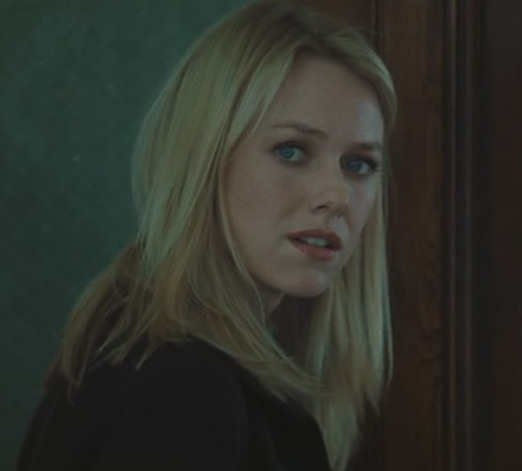
Sidebar: I might have developed a bit of a crush on Naomi Watts when this movie came out. Crush, as it turns out, still active.
Rachel’s a career-driven single mom of a son who spends his time apparently engaging in extrasensory perception normal kid things and drawing seriously disturbing totally normal pictures at all times:

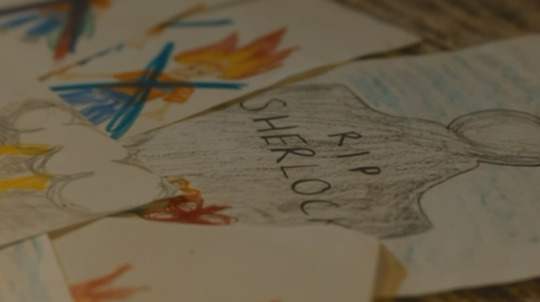
(Not yet, Eurus!)
The story of The Ring starts when Rachel’s teenaged niece dies under mysterious circumstances, and Rachel’s sister, the dead girl’s mother, asks Rachel to investigate. The trail leads Rachel to what sounds like an urban legend about a cursed videotape.
She finds the tape at a creepy mountain resort, and watches it. It is, in essence, a mishmash of images set to an unsettling minimalist soundtrack:
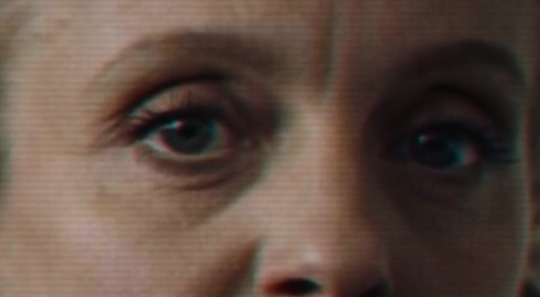
Sorry, wrong creepy recording. This is the one from The Ring:




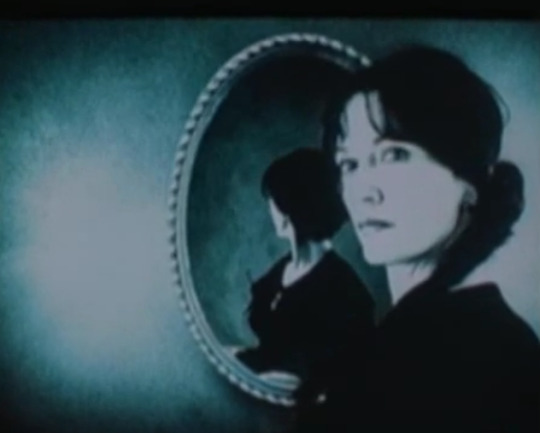


Yeah me too. (Note the nearly-fourth-wall-breaking gaze...remind you of anything?)

Hi, John. (Via @inevitably-johnlocked, specifically this answer.)
I’ll just say here that, in addition to seemingly casting himself as Plane Girl and Eurus throughout parts of TFP, John’s role as John in TFP overlaps with much of Rachel’s in The Ring. Rachel’s standout characteristics are her dogged attachment to the investigation and her somewhat deadbeat qualities as a mom. I’ll leave you to your deductions about why John probably identifies with her.
Immediately after Rachel watches the tape, the phone rings. When Rachel answers, a voice says, “Seven days.” We already know, from her previous investigations, that people die seven days after they watch the tape. Now she knows there’s something to the story, and we have a ticking clock motif--a handy thing that builds extra tension into any plot.

Tick tick tick, Jim!
I’m going to skip most of the investigative twists and turns in The Ring, because this movie is a treat, and half the fun is watching the evidence pile up that something supernatural is responsible for the mysterious deaths.
Long story short, Rachel’s investigations lead her to discover that the videotape is linked to a horse-loving couple whose possibly weird-scientifically conceived daughter caused a lot of trouble during her brief lifetime.
Oh, and they live on a remote island that you can only reach via boat.

Sorry, wrong island.
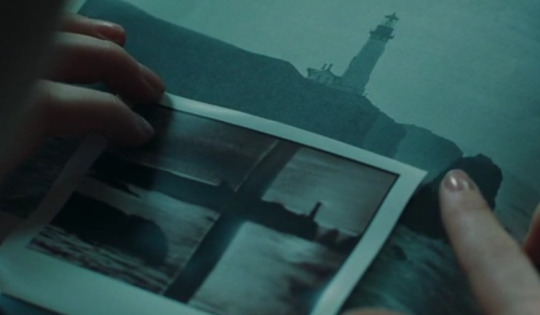
This weird island is the one from The Ring. Totally different island. This is the one where, while the weird girl with psychic powers was still alive, she seems to have subjected the residents to her whim. (*cough cough cough*)
ANYWAY--
Rachel interviews the girl’s father and gets nowhere, but the island’s doctor is a little more talkative.
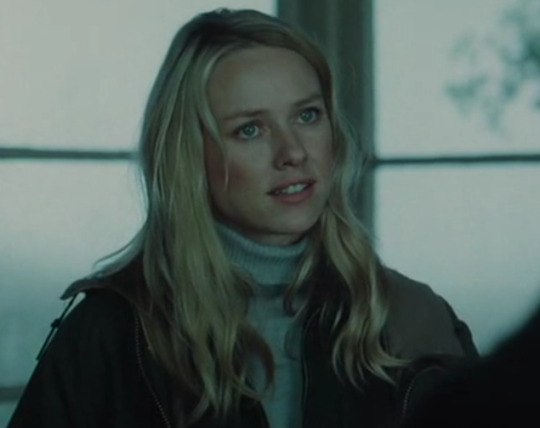

Important Backstory Alert:
Doctor: She wanted a child more than anything, poor Anna. They tried hard for years, but sometimes it’s just not meant to be. Then one winter they went away, and when they came back, it was with Samara. [I have to interject here to say you could argue that watching the tape means you have an APPOINTMENT WITH SAMARA, lol] ... Everything was fine, ’til Anna started coming to see me. Said she was suffering visions, seeing things, horrible things, like they’d been burned inside her. It only happened around Samara, that the girl put them there.
Okay. I just want to put a pin in that and go to TFP, because this is where we get some major intertextual action:
MYCROFT (firmly): I am aware of the dangers Eurus poses, and equipped to deal with them.
JOHN: What dangers?
MYCROFT (straightening up): Eurus doesn’t just talk to people. She ... reprograms them.
(John turns back to look at the screen.)
MYCROFT: Anyone who spends time with her is automatically compromised.
(all transcripts via Ariane de Vere)
Eurus is like the little girl from The Ring, putting ideas in people’s heads. As many, many people have noted, her hair and clothing in TFP are very close to Samara’s.

See what I mean?

Like Eurus, we see Samara through a television screen. Here, Samara is depicted in old footage of a psychiatric interview:

One of many iterations of televisual Eurus:
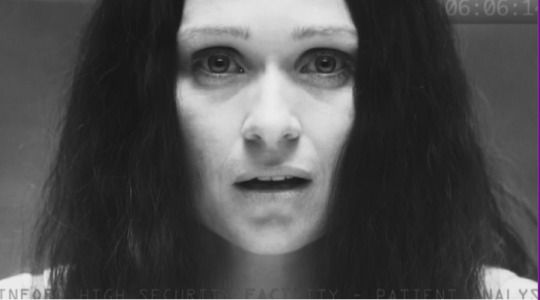
(The Ring plays very substantially with the uncanny nature of television, its habit of invading our domestic spaces, and the way that we can be manipulated and even threatened through the set. I suspect there’s something similar going on with TFP, especially in light of increasing evidence that it’s the setup to an ARG--TFP is the bait, the inciting incident, that leads us into the game.)
In any case, Eurus, as we have her in TFP, is an interesting mix of Samara from The Ring and a figure from John and Sherlock’s past. In The Ring, Samara manipulates people by “showing them things”--she puts pictures in their heads. But Eurus “talks to people,” and, somehow, makes them do things.

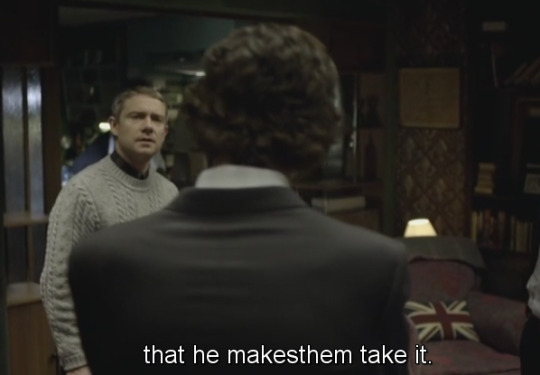
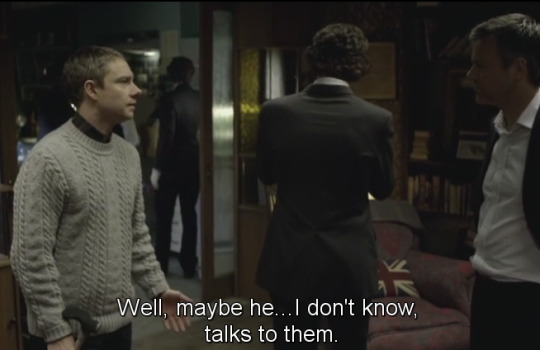
In TAB, on his way to his death, Sherlock read John’s blog, the story of how they met. Here, in TFP, on the verge of death, John is hallucinating a blend of motifs from horror movies and that same story--the story of how he and Sherlock met, with their first bad guy (Jeff Hope) blended together with their most recent (Eurus), and a substantial dose of Samara in the mix.
All of this evidence is plentiful enough to say there’s definitely a connection between The Ring and TFP. None of this begins to cover the sheer lunacy of the climax of TFP, and its very, very strong resemblance to the penultimate plot points of The Ring. Buckle in for a trip to bonkersland.
The Ring’s False Climax and The Non-Finality of TFP
The action of The Ring comes to its first, and fake, climax, as Rachel is running out of time. It’s the seventh day of her seven-day adventure, and she’s on Murder Moesko Island trying to figure it all out. Even as her previous ex-commander ex-boyfriend, Noah, struggles to dig up some information on the Morgans’ daughter at a nearby mental hospital, Rachel sneaks into the Morgan family farmhouse and watches a tape from the hospital’s archive:
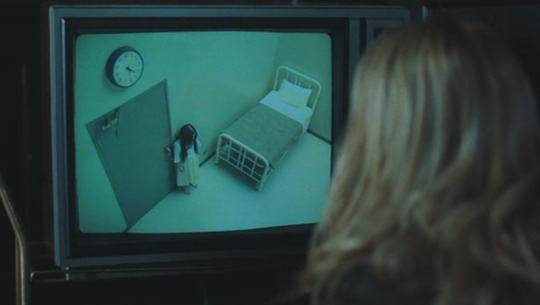



Interviewer: So what is it that’s keeping you awake? You must sleep sometime. Do you dream about something? Samara?

Interviewer: Let’s talk about the pictures. How did you make them? Samara? How did you make these pictures?
[Sidebar: the pictures are amazing]

Samara: I don’t make them. I see them, and then, they just are.
Interviewer: Samara, I need you to start telling me the truth, okay?
Samara: Can I see my Mommy?
Interviewer: No, Samara, not until we understand what’s wrong with you.
Samara: I love my Mommy.
Interviewer: Yes you do. But you don’t want to hurt her any more, now, do you? You don’t want to hurt anyone.
Samara: But I do, and I’m sorry. It won’t stop.
Interviewer: Well that’s why you’re here. So I can help you to make it stop.
Samara: He’s going to leave me here.
Interviewer: Who?
Samara: Daddy.
Interviewer: They just want to help you.
Samara: Not Daddy.
Interviewer: Your Daddy loves you.
Samara: Daddy loves the horses. He wants me to go away.
Interviewer: No he doesn’t.
Samara: But he doesn’t know.
Interviewer: He doesn’t know what? Samara?
[The tape cuts off.]
This is lovely horror movie stuff, well done. (If anyone wants to explore the above text in terms of potential connections with John, Mary, and Rosie, or in light of Eurus’s nonsense monologues / psychiatric interviews in the background of TFP, go ahead. I’m not planning to, but I think it’s a potentially rich vein.)
We have the evidence that there was something very wrong with Samara, and the witness (Rachel) who interprets what she sees as evidence of child abuse. As The Ring builds to a series of reveals, we’re pulled in two different directions: we have the evidence that this child has powers, that she’s used them malevolently, and, on the other hand, the idea that she should have been protected, she was just a child, and therefore can’t be responsible for what’s happened to her.

Rachel, persisting in her idea that Samara just needed / needs to be understood, and that she’s uncovered some terrible story of abuse, continues to investigate.
Similarly, the narrative of TFP pulls us in two different directions. Eurus is both a little girl who somehow just needs a hug, and the demon seed who had, and has, no trouble killing wantonly.
Since Eurus can be read as a proxy for John (and this is part of where TFP takes on serious dramatic weight), we have both sides of him, as well. John needs to be rescued.

John is also full of self-blame.

He casts himself in both roles, with one resolution: his own rescue.

In The Ring, Rachel, now joined by her previous ex-commander ex-boyfriend Noah, first SEEK MY ROOM find Samara’s room, which is located in a symbolic Rapunzel’s tower hello damsel in distress at the top of the world’s tallest barn:
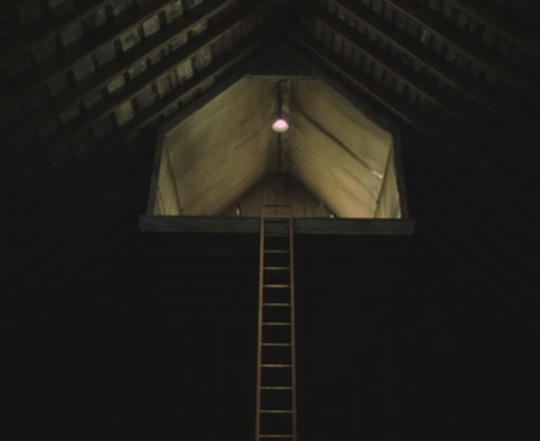
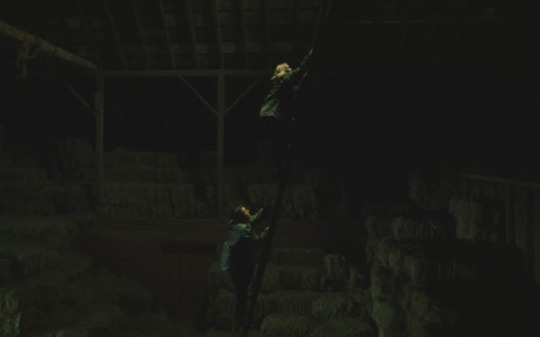
After approximately fifteen minutes of climbing, they find this oddly-normal-looking-for-where-it-is little girl’s room:
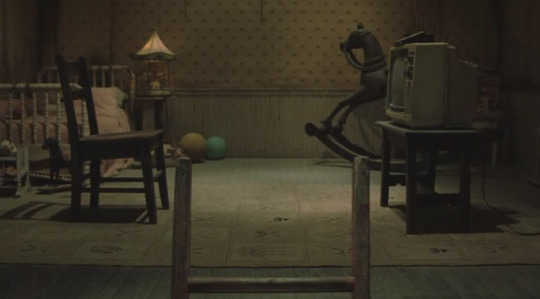
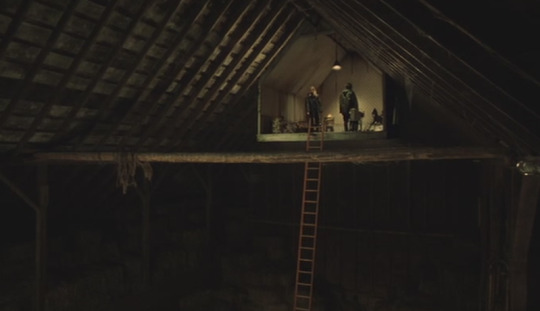
Compare:

Samara’s room, like Eurus’s apparently normal childhood bedroom, hides darker intentions and secrets. In this case, hidden under the wallpaper:
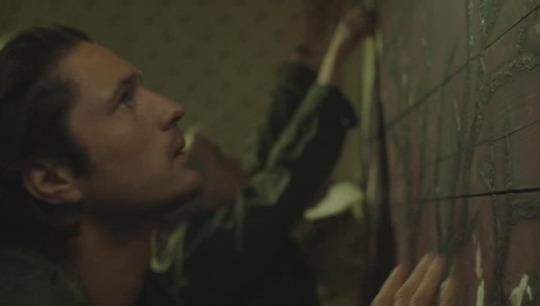

The burning tree image they uncover is a clue that leads them back to the inn where Rachel first watched the tape.
There, in the cabin, Noah and Rachel search desperately for the reason why they’ve been led back to this place. Rachel makes an impassioned plea for Noah to help their son (who has also watched the tape, and is under the same curse). Noah temper tantrums spectacularly--

--Noah temper tantrums spectacularly, knocking a conveniently placed vase of glass beads onto the floor. They roll and form an arrow that points to the solution:



(Did I mention that the room in The Ring is “painted red” by the setting sun shining through the red leaves of a tree? Just saying.)
Rachel and Noah figure out that there’s a hidden well underneath the floorboards on the cabin. Noah fetches an ax and smashes up the floor, an act that takes approximately a million years of screentime but is very manly:

Go, Sherlock!
Go, Noah!



What is it called when you break through the floor instead of the fourth wall? Lol.

Here’s where things get really ridiculous.
A tv, possessed by the spirit of the dead girl, knocks Rachel into the well.
No, really:

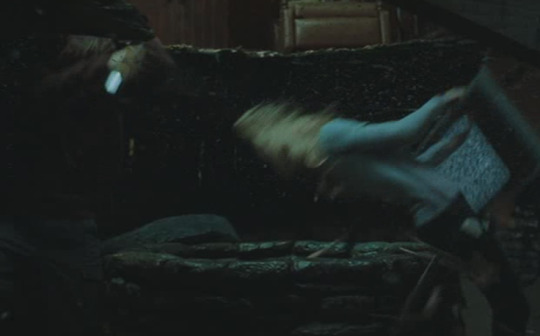
I know, totally different from being put in a well by a person who broadcasts herself through a tv and who everyone thought was dead, but you know.
The fall knocks Rachel out. She wakes up in the well:
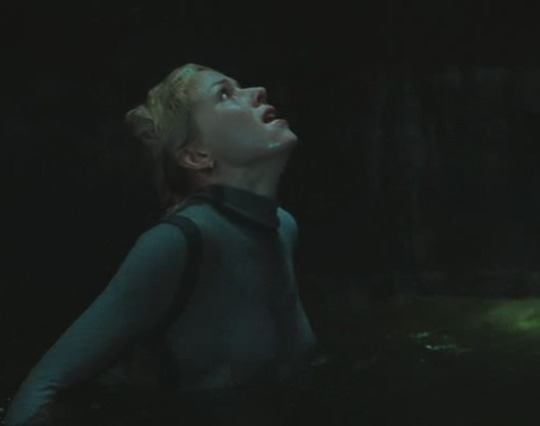
Rachel: I’m here.
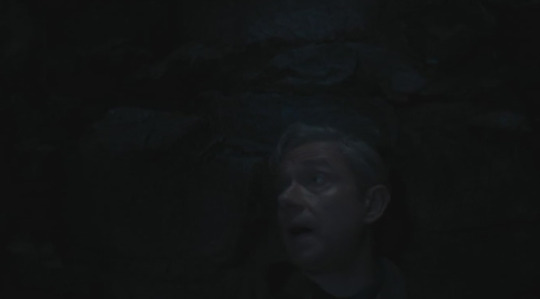
John: Yeah I’m here.
Rachel finds gruesome evidence that Samara was trapped in the well, alive, for a while.
The lid slides over the well--Rachel is trapped. She pulls up a handful of hair from the water, a hand emerges to grip her wrist, and we’re off into flashback territory:

Rachel receives a vision, presented as a flashback, about Samara’s murder. At first we see what seems to be a childhood idyll, accompanied by Samara’s singing:
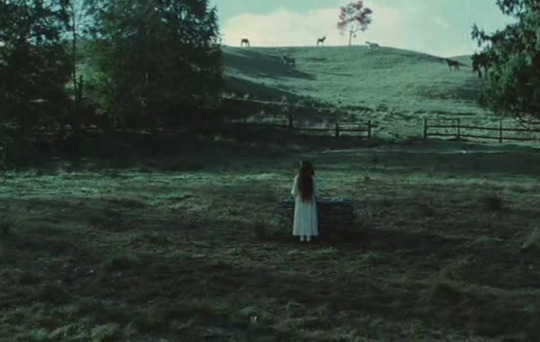
Round we go
The world is spinning
When it stops
It's just beginning
Sun comes up
We live and we cry
Sun goes down
And then we all die
[x]

But, we find out that this is actually the scene of her murder, as her mother approaches from behind her, puts a plastic bag over her head, and pushes her into the well:

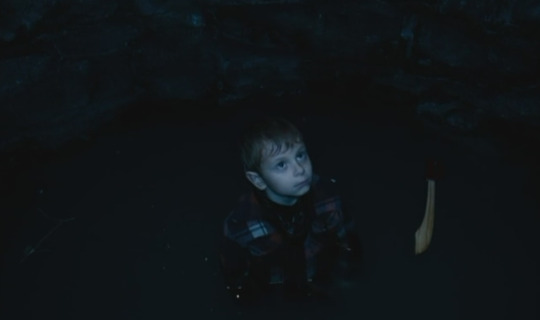
Meanwhile, at the bottom of the well, Rachel pulls Samara’s body up out of the water. She comforts her:

Rachel: It’s okay now. It’s okay.
This parallels Sherlock’s puzzle solving on the surface, so he can find Eurus and save John.
SHERLOCK: I ... am ... lost ... Help ... me ... brother ... Save ... My ... Life ... Before ... my ... Doom.
(He continues swiping the words away.)
SHERLOCK: I ... am ... Lost ... Without ... your ... love ... Save ... My ... soul ... seek ... my ... room. [x]
The gravestone puzzle allows him to find Eurus, and comfort her.
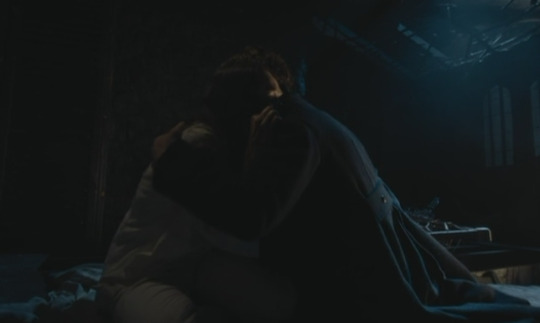
SHERLOCK (in a whisper): You’re not lost any more.
Here we have it: a clear emotional climax for TFP--the climax that happened instead of the emotional resolution we were looking for, between John and Sherlock, but a climax nonetheless, if only in strictly structural terms.
In The Ring, this is the moment Samara’s body dissolves into bones:
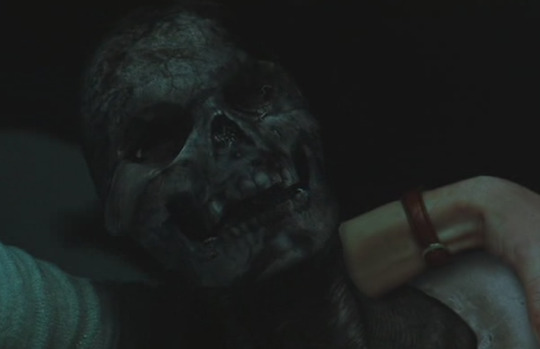
Meanwhile, in John’s Well of Feels:

This moment in The Ring offers an escape from death for John Rachel. The curse doesn’t kick in: she doesn’t die, even though her seven days are up. She believes that, in discovering the true story of Redbeard Samara, she’s solved the puzzle and broken the curse. She contemplates the importance of understanding Samara, in the aftermath, as a surprising number of emergency workers and police crowd around this remote location, no doubt in response to Noah’s and Rachel’s call.
The Ring:

TFP:

Noah talks with Rachel about what happened, comforting her as she’s wrapped in a shock blanket, looking tired and worn out and damp:

Rachel: [About Samara] She just wanted to be heard. Sometimes children, they yell or cry or draw pictures.
In case you’re having trouble telling at this point, this is from TFP, not The Ring:


John: Well, you gave her what she was looking for: context.
Sherlock: Is that good?
John: It’s not good, it’s not bad. It is what it is.
[And what it is, is shit, friends, or, more hopefully, about to go to shit in the most amazing way possible. Hang on: this meta has one more loop around the track to go.]
In both The Ring and TFP, this looks like closure, doesn’t it? It looks like the show’s over. TFP certainly did its darndest to pantomime an ending after this. And yet--
WHY IT ISN’T OVER YET
Now we come to the point, the entire point and the thing that inspired this post. If John is drawing inspiration from The Ring in his hallucination--and I am certainly convinced that he is--then we ARE NOT DONE.
The above is not the climax of The Ring. It’s a nice version of a ghost story: if someone could only just learn the truth, then we could put the haunting to rest.
What a tender world that would be.
Rachel goes home, and tells her son, who has also been cursed, that she solved the puzzle.
Aidan: What happened to the girl?
Rachel: Samara?
Aidan: Is that her name?
Rachel: Mm hm.
Aidan: Is she still in the dark place?
Rachel: No. We set her free.
Aidan: You helped her?
Rachel: Yeah.
Aidan: Why did you do that?
Rachel: What’s wrong, honey?
Aidan: You weren’t supposed to help her.
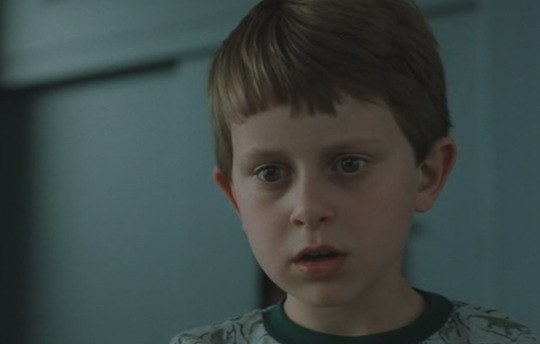
[^ my approximate feelings immediately after watching TFP for the first time.]
Okay so, let me fill you in on how freaking amazing The Ring was, as a first time viewing experience, when it came out. Horror had, as horror does, gone through a particularly shitty slump at this point. The decision to import motifs from J-horror was among one of the best things that could have happened to Hollywood, however you feel about cultural appropriation / this style of collaboration. The above moment, in which the not-at-all-creepy child informs Rachel that she is wrong, that she has in fact made a terrible mistake, was, simply put, a really standout moment in the history of horror cinema. It was the thing that people talked about when they talked about The Ring.
The false climax of The Ring is the thing that distinguishes it. Borrowing that false climax to the point where, beat for beat, it informs the climax of your horror pastiche episode, as Moftiss have done in TFP, is akin to jumping up and down and screaming, THERE! IS! A! TWIST! COMING! THIS! IS! NOT! OVER!
So, what’s still to come?
In The Ring, the twist is that Rachel actually avoided the curse when she made a copy of the videotape, during her research. Like a smart virus, Samara’s curse forgives the person who propagates it.
If you don’t pass it on, you die. The curse is very much still active in the world of The Ring, which we find out when it gets Noah (poor Noah!). Here we learn the true nature of death-by-Samara. Basically, she breaks the fourth wall, climbing through your television set to come get you:

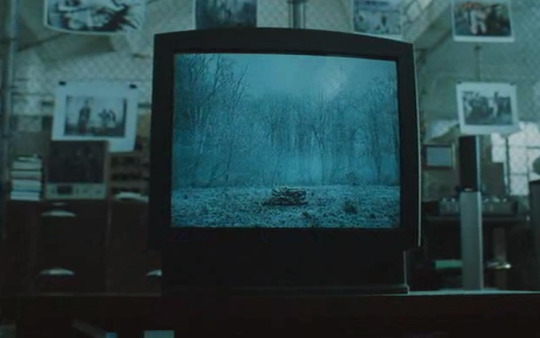
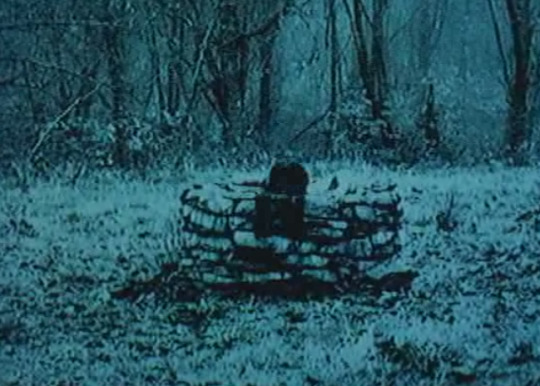

A fourth wall break so extreme, it’s lethal!
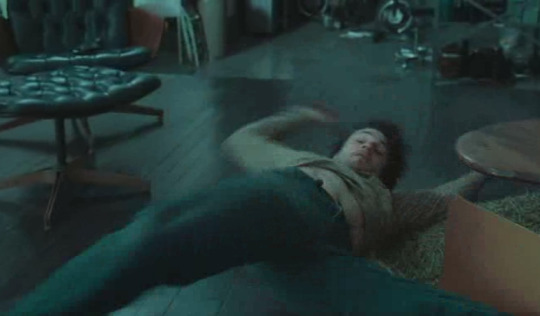
I know, Noah, this is how I feel about the ARG too.
Noah dies, leaving Rachel to figure out that the key to saving her son from the curse is to have him copy the tape:

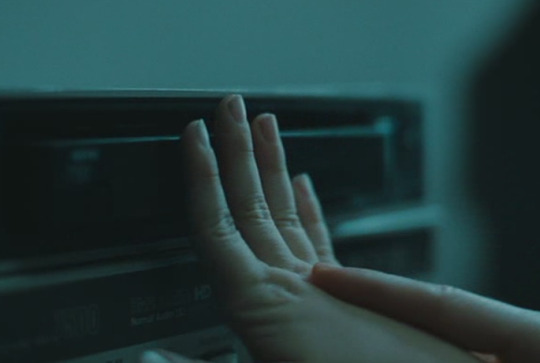
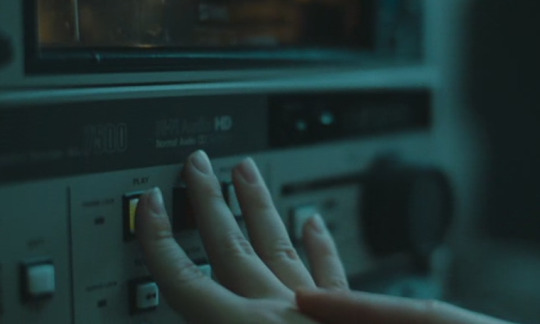
This is Moftiss, showing you how to hit reblog on those ARG posts that you find scary, but which somehow seem increasingly important to your survival, post s4.
Bottom line, the ending of TFP, in copying the false climax of The Ring--in addition to its numerous other signs that it is not seriously offering any kind of resolution or closure for its audience--indicates that it is fake as hell. The story is not over, there is more coming for our heroes, and much more coming for us.
tagging:
@devoursjohnlock @marcespot @waitedforgarridebs @221bloodnun @jenna221b
I should probably tag others but I’m exhausted, please feel free to pass this on.
518 notes
·
View notes
Photo

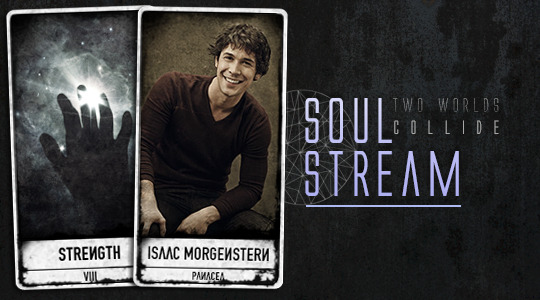
Welcome Hillary! We are happy that you are joining us in Soulstream. Isaac is definitely a great addition to the RP (and our first Tuner OC!) We are excited to see how being a deaf Tuner would be played, and how his plot will progress. Please make sure to follow everyone on our masterlist and our gossip blog. Follow the tags for announcements, starters, follows & unfollows, as well as events. Also, make sure that your submit is activated for OOC chat link purposes.
OOC Info.
Name: Hillary
Age: 25
Preferred Pronoun: she/her
Timezone: EST
Tumblr Contact Info: persephoning.tumblr.com
Activity Scale (1-10): (please add an explanation) 6/10, as I’m a working adult and sometimes the muse just isn’t there.
IC Info. Original Character
Character Name: Isaac Morgenstern
Age: 30
Character Type: Tuner
True Name: “Panacea”
FC: Bob Morley
Sexuality: Pansexual
Date & Place of Birth: February 1st, 1987
Occupation: Medical Researcher
Family:
Sarah Morgenstern (adoptive mother)
Tania D’Angelo (adoptive mother)
Connections: I spoke at length with Admin Rhi about a close friendship between Isaac and Miguel Soto, but whether or not that would/should be on his bio is up to her entirely.
Background:
What he would want to make clear (in the conversation he never has, in the explanation that he dreads giving) is that he always has the consent of the people that he takes on as vessels once his latest has started to buckle under the wear and tear of his abilities. Isaac is an old Tuner, he has long since lost count of the years that he has existed, but he remembers the people who have given him their lives to use as his own, even if their names have melted into memory and he only has tiny fragments of the lives of the oldest left. He has their consent and often their sympathy, as he has never taken on a vessel without befriending them first, and it is, in his experience, quite difficult to say no to someone you consider a friend when they’re explaining to you the many ways in which they are dying. What clinches it is that he has always worked in the medical field one way or another, and he has always taken vessels who do the same, counting on the camraderie of the battlefield, the hospital, or the clinic to bind them further.
It makes things easier, both on them when the time comes for him to reveal his gifts and make his case, and on himself, when he has time to reflect on the number of lives he has taken over in his time. Isaac Morgenstern is one such life, a pre-med student at a local university that he befriended ten years ago when his last vessel was fading from overuse. There are some among his kind who prefer to take from the restless or from those who had been seeking to end their lives, but Panacea convinced Isaac on three fronts: curiosity, generosity of spirit, and guilt of the highest order. In truth, he might have lied to the boy a little. He had no way of knowing if the transfer of Isaac’s body to his soul would reverse his deafness, and so it was lucky that that boy had no way of knowing otherwise once the deed was done and the Name was merged with himself. Isaac has done far more healing and twice as much good since then as he could have as a plain mortal, and it is that fact that he clings to when their own guilt starts to nag at them. True, he had misused his vessel that last time and burned their energy too far and too fast, but the lives that he had saved by doing so, they were worth something, weren’t they?
On the whole, he tries not to think about it at all. He keeps his adoptive mothers at a comfortable distance, with occasional uncomfortable phone calls to bridge the thousands of miles that he has put between them since taking over his life ten years ago. It was easier to be around them when he was freshly reborn, when Isaac’s memories reigned supreme in this vessel’s mind, but those days have long gone by now. He thought it best to leave after graduation, to dart across the country and create a new Isaac in a new place, with just enough of a veneer of the old to please the women who gave him access to the boy’s trust fund. The people of Port Ashborne know a different Isaac to that of the people who knew him in his younger years, but there are enough similiarities between the Tuner and the man that he could pass if he were so unlucky as to bump into an old school friend or distant relative. That isn’t too difficult, but communicating with spirits?
That was exceptionally difficult to finagle after centuries of being able to hear and speak to them at will. There were a lot of very frustrated souls in the beginning, quite a few thrown objects and scrawled messages on the floor of his dorm room in Sharpie when he tried to ignore them for a time. Since then he’s learned to adapt, there are whiteboards left all over his apartment for their use and his, as well as a tablet computer that he carries around to help him communicate with the less dead members of society. He isn’t as fast as he used to be, as far as his Tuner duties to the Soulstream go, but his healing ability continues unimpeded. After all, you don’t need to hear or speak to a person to see that they’re injured, even though he doesn’t actively seek out mortals to heal anymore. This too shall pass, this vessel too shall decay and be worn down by the demands of his ability, but until then, he’s satisfied with where and whom he is for right now.
Additional Information:
When stressed or sleepless (though most often both), Isaac has a habit of getting up in the wee hours of the morning to bake or cook, often in the sort of quantities that even his chest freezer can’t handle. He feels that it helps him untangle problems, for there is comfort to be found in the completion of that task. It’s also something that doesn’t really require him to think, and so the rhythmic nature of cooking can help him force a solution out of his mind. It helps him bond with his coworkers as well, being a constant source of free lasagna or brownies.
Since he isn’t actually practicing medicine this time around, Isaac finds that he spends more time than usual working with spirits of the dead and guiding them back to the Soulstream. That’s more difficult these days, but he found that learning how to jump those hurdles improved his ability to communicate with the living as well. Isaac himself could passably lip read and knew ASL before he became a Tuner, though it’s far easier to type or write. He carries a tablet with him always for this purpose.
Personality:
In truth, Isaac isn’t all that sure anymore where his True self, his Tuner self, and the personality of his vessel ends. By nature he is kind and gentle, but he can also be harshly pragmatic and selfish when needs must. He will burn the lives of his vessels down faster than average to heal those who need it, but he also will actively target those he befriends in order to find a proper vessel for the time when his own starts to fail. The continuation of his work, of his healing and his shepherding of the souls of the dead back to the Stream, that is far more important to him than the autonomy of most any other mortal. (Whether or not this is a fear of the void, the death that would come if he didn’t so carefully plan out his future vessels, remains to be seen.) If the situation requires it, he has no problem with using guilt and his keen observation skills to manipulate someone to get his way.
Skills:
Like his true name implies, Isaac can heal almost any wound from the minor to the grievous by touch and focus alone, but there are limitations. He can’t heal his own vessel, and the healing he does is wholly dependant on the energy of that vessel. If he’s careful and doesn’t use more energy than his vessel could possibly take in by eating or sleeping in one day, he doesn’t damage their bodies, but that is an art that he has yet to master. As it stands now, he tends to use his vessels up far earlier than others of his kind and thus shortens their lifespans with every person he heals. His rationale is that his healing is in fact a thousand times more effective than any healing that those healthcare workers that are his preferred vessels could have managed themselves, and that with the hours that the average healthcare worker puts in every week, he’s only increasing the pace at which they wear themselves down. Or so he tells himself.
Isaac Morgenstern was of average build when he became a Tuner, but like many Tuners, he’s stronger than average and has better reflexes, sharper senses (except hearing of course). However, he doesn’t heal as quickly as some of them do. Faster than a mortal, but not as fast as some, which he thinks might just have something to do with the machinery of his ability. Not the worst thing in the world.
Since the vast majority of his past selves have worked in medicine or healing, Isaac is exceptionally skilled at his chosen profession, and would be more obviously so to others if he still practiced face to face. This vessel’s limitations have made that rather impossible though, and though that is somewhat disappointing, it does mean that he isn’t using his healing as much as he used to.
Sample Paragraph:
He could have borne the rattling of the dishes, the occasional angry message scrawled on the kitchen counter in ketchup as he tried to grapple with the ghost that had invited itself into his new apartment, but waking up at three in the morning because it had decided to turn on all the taps in his bathroom to the point that there was an inch of water on the floor was a tad too far. Isaac had left notes, he had encouraged the ghostly young woman to use the large rolling whiteboard in the living room to tell him what it was that was keeping them here on Earth, but this one had refused to follow his directions at every turn. That and the bill he received from the plumber later on made it clear that he had to take some more drastic measures to ferry this soul back to the Stream. At the Target later that day he bought groceries, fresh dry erase markers, and of all things, a Ouija board. They could yell all they liked (and he knew they were yelling, the vibrations were unmistakable even if that was all he could pick up on), but if they lost him his security deposit, he was going to be pissed.
The rattling started again as he was finishing up with putting groceries away, and Isaac made a vague disgruntled noise as he shut the refrigerator. A friend at work had recommended an app that would take text and make it into a computerized voice, but he set the Ouija board out on the kitchen island as well. Better to be overprepared than not at all, as far as he was concerned. Something must have worked though, for not thirty seconds after he had typed ‘I know what you are, but I’m deaf, so yelling isn’t going to help either of us’, the plate that had been levitating behind him fell into the sink with a splintering crash as the girl glared at him. ‘You’re going to have to write on the board or use this stupid game to talk to me’ got him an icy breath of air on the back of his neck, but ‘You can’t move on unless you talk to me’ finally made her pick up the dry erase marker. If this worked, he was going to have to bake Minh a small bakery’s worth of stuff, but it would be worth it.
At first he was relieved to see that she was writing on the whiteboard, but then? Then he was disheartened, if not actively upset by the contents of what was written there in harsh red letters. ‘What if I don’t want to move on? What if I’m afraid?’ the ghost’s message read, and Isaac sighed as he slid off of the kitchen stool that he had been sitting on earlier. Tablet in hand, he erased what had been written before and tried to type out an answer. There honestly wasn’t a good answer to those questions, not one that he wouldn’t have to sweeten and frame as carefully as possible. ‘We all are, one way or another’ the tablet said, and then Isaac erased the message so that he could continue the conversation. Maybe a little truth would help here, and so he typed out ‘Even me’ before tapping the play button once more. ‘This isn’t your world anymore, but I can tell you about the world that is. And I can take you there, once we’re done.’ The pause that followed that statement seemed to go on forever, and for a moment Isaac thought she had been scared off by the very idea of being helped along. He was just about to drop his tablet on the counter in defeat when the ghost scrawled ‘Okay’ on the board. He could work with that, and maybe, just maybe he could get them out of here before they entirely destroyed the apartment. Maybe was good enough for now.
0 notes